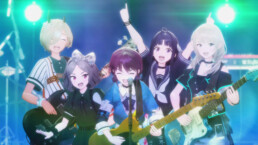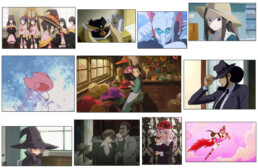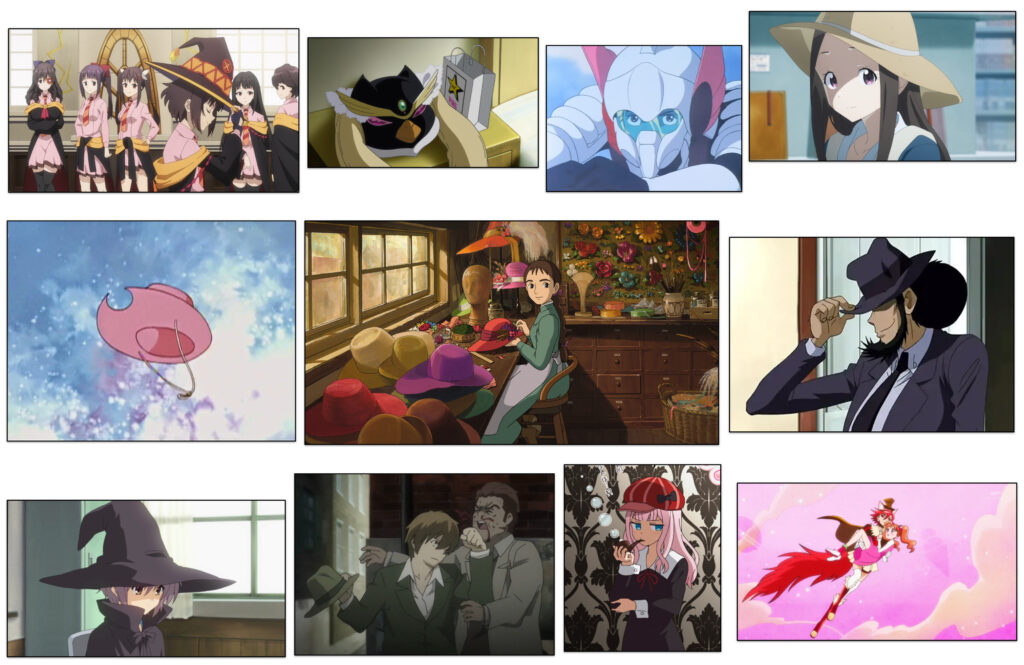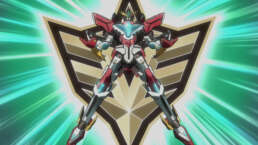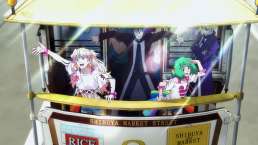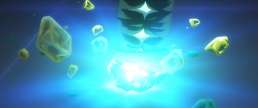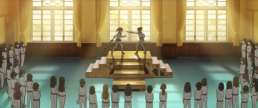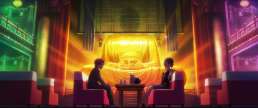Symphogear Episode 09: Protector's Song
Episode Summary:
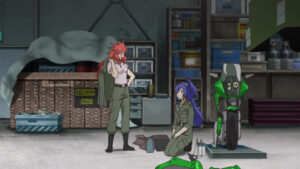 We start back in the past in a brief flashback where Tsubasa remembers Kanade encouraging her to sing more outside their work of fighting Noise. Tsubasa wakes up a short time later in the present after having one last scan to determine that she has finally recovered from her Superb Song.
We start back in the past in a brief flashback where Tsubasa remembers Kanade encouraging her to sing more outside their work of fighting Noise. Tsubasa wakes up a short time later in the present after having one last scan to determine that she has finally recovered from her Superb Song.
Miku is being let into the secrets that Hibiki has had to live with the past few months. She meets Tsubasa and they have a laugh at how accident prone Hibiki is. Ryoko walks up and starts to regale the girls with a tale of a time she fell in love, only to oddly cut herself off when she being to link that past love to the reason she started researching the Symphogear relics. As the conversation with Ryoko ends, Hibiki suggests that she, Miku and Tsubasa go on a date out. Tsubasa reluctantly agrees.
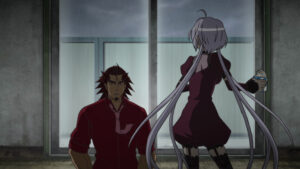 Meanwhile, Genjuro has taken a brief leave of absence saying he is returning one of his rented action movies… but he’s been gone longer than usual. It turns out he has tracked down Chris Yukine and is working to slowly gain her trust by just talking to her and bringing her much needed food. Chris is still angry at all the adults that failed her, but converses with Genjuro a bit before fleeing the uncomfortable conversation. Still, it’s a start.
Meanwhile, Genjuro has taken a brief leave of absence saying he is returning one of his rented action movies… but he’s been gone longer than usual. It turns out he has tracked down Chris Yukine and is working to slowly gain her trust by just talking to her and bringing her much needed food. Chris is still angry at all the adults that failed her, but converses with Genjuro a bit before fleeing the uncomfortable conversation. Still, it’s a start.
Tsubasa’s day trip starts out on the wrong foot as Hibiki and Miku are late because Hibiki overslept. But things soon get better as Tsubasa is given the chance to do regular everyday activities for the first time in as long as she can remember. The three go shopping, watch a sappy romance movie, buy clothes, and sing karaoke. Tsubasa surprises the other two when she begins to sing. Instead of choosing one of her j-pop songs, she instead goes with something that sounds like a Samurai-era song of passion and regret.
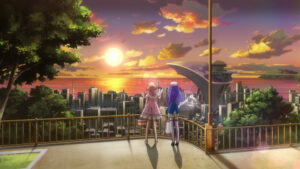 As their trip comes to an end, Tsubasa realizes that this is the world that Kanade saw. One of just normal fun outings with friends beyond the pains and struggles of war against the Noise. Hibiki agrees, but reminds Tsubasa that the peaceful city vista before them would not even exist if Tsubasa hadn’t fought to hard for it. Tsubasa make the decision to return to her singing career and gives Hibiki and Miku tickets to her next event.
As their trip comes to an end, Tsubasa realizes that this is the world that Kanade saw. One of just normal fun outings with friends beyond the pains and struggles of war against the Noise. Hibiki agrees, but reminds Tsubasa that the peaceful city vista before them would not even exist if Tsubasa hadn’t fought to hard for it. Tsubasa make the decision to return to her singing career and gives Hibiki and Miku tickets to her next event.
A few days later, Tsubasa is back on stage, back at the theater where she lost Kanade. Hibiki is, of course, running late, but then gets a call that Noise have appeared elsewhere in the city. At Hibiki’s request, Genjuro does not call in Tsubasa, opting to let her continue her performance while Hibiki handles the noise alone. Except, it turns out Hibiki is not alone. Chris is there, too, fighting a giant fortress Noise for her own reasons.
 What follows is a gorgeous song by Tsubasa intercut with Hibiki and Chris’ battle against the Noise. Though the two former enemies barely interact, Hibiki and Chris do end up supporting each other and eliminate the Noise all without getting in each other’s way.
What follows is a gorgeous song by Tsubasa intercut with Hibiki and Chris’ battle against the Noise. Though the two former enemies barely interact, Hibiki and Chris do end up supporting each other and eliminate the Noise all without getting in each other’s way.
In the end, Tsubasa admits to her audience how much singing means to her and asks them if they’ll allow her to expand abroad and bring her songs to more and more people. She is delighted when they give her a cheer of support. Tsubasa is finally back where she is meant to be… Meanwhile, Chris is alone back in an alley confused as to why she helped Hibiki fight the Noise.
Episode Impressions:
This is a good episode. The show is still moving things into place for a big finale, but that doesn’t mean important things aren’t happening. Tsubasa seems to have finally come to terms with her role in fighting the Noise. She isn’t abandoning being a warrior, but she has accepted that her songs can be used for other, better purposes than fighting.
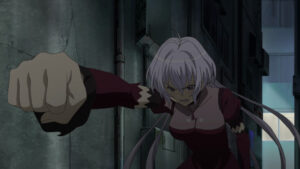 At the same time, Chris has gone from an outright enemy to a reluctant ally. She’s still struggling with the twisted worldview Finé forced on her, but she is no longer out there hurting people or doing Finé’s dirty work. Chris is actually out alone risking her life to protect others!
At the same time, Chris has gone from an outright enemy to a reluctant ally. She’s still struggling with the twisted worldview Finé forced on her, but she is no longer out there hurting people or doing Finé’s dirty work. Chris is actually out alone risking her life to protect others!
With Tsubasa healed up and her relationship with Hibiki turned around, I think all we have to do is bring Chris into the mix and we’ll have a powerful trio to fight Finé and the Noise.
Specific Scenes I Loved:
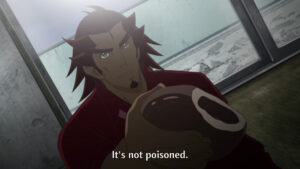 Genjuro demonstrating to Chris that the food he brought her is not poisoned by eating and drinking a bit of it before he hands it over to her. Chris has spent the last several years of her life being abused by the adults around her. Genjuro is taking it one small step at a time to gain Chris’ trust.
Genjuro demonstrating to Chris that the food he brought her is not poisoned by eating and drinking a bit of it before he hands it over to her. Chris has spent the last several years of her life being abused by the adults around her. Genjuro is taking it one small step at a time to gain Chris’ trust.
Tsubasa’s concert. Her song is so obviously about herself. And the way it is used as the combat music is great.
Songs In This Episode:
Koi no Okehazama – This is such a Japanese love song. One that is seemingly being sung by a maiden warrior in love but also alight with jealousy and emotion. The full song doesn’t seem to have a ton of relevance to the episode or show. It’s just something that might have been written by a young warrior similar to Tsubasa hundreds of years ago.
FLIGHT FEATHERS – Wow. This is a song from Tsubasa to and about Kanade. In it, Tsubasa sings about being drawn to Kanade. About losing her but not wanting her memory to disappear. And about remembering the lessons Kanade taught her. There’s also strong implications that Tsubasa has accepted everything that’s happened and plans to continue confidently down her road.
Themes In This Episode:
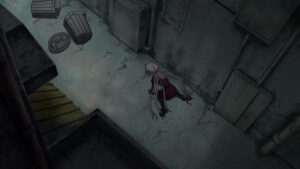 While it’s not really spoken, we see Chris struggling at the end with the reality of her wish to bring peace to the world through strength and violence. Mostly, we see that Chris is distraught and confused because Finé taught her she needed to have no friend and get no help from others… and yet during her big battle with the Noise not only did she fight alongside Hibiki who believes fighting is a last resort, Chris actually helped Hibiki out in a couple of instances and got help in return. Chris is dealing with a bad worldview that has been shattered by Hibiki’s good actions. And she hasn’t quite made it through those struggles yet.
While it’s not really spoken, we see Chris struggling at the end with the reality of her wish to bring peace to the world through strength and violence. Mostly, we see that Chris is distraught and confused because Finé taught her she needed to have no friend and get no help from others… and yet during her big battle with the Noise not only did she fight alongside Hibiki who believes fighting is a last resort, Chris actually helped Hibiki out in a couple of instances and got help in return. Chris is dealing with a bad worldview that has been shattered by Hibiki’s good actions. And she hasn’t quite made it through those struggles yet.
There’s a lot in this episode about Tsubasa finally finding herself in the world that Kanade found. The world beyond the fighting. Kanade, as we know, was a very messed up kid who had watched her family die to the Noise. But, over time, she realized that helping people was more important than her personal revenge. It’s probably why she loved her concerts with Tsubasa so much. It was a chance to help without having to fight.
Tsubasa mostly just seemed shy and overwhelmed before Kanade died. Afterwards, she was angry and mournful. She dedicated herself to the combat side of helping people and neglected everything else. But now, with Hibiki showing the way, Tsubasa has found her way to where Kanade was before she died. Tsubasa now understands that the war against the Noise is just what is necessary to create and preserve that world of shopping and singing and goofing off that Hibiki has been trying to show her.
There’s one last theme that’s interesting in this episode. Tsubasa, then Ryoko, and Finally Chris all wonder why something about them has changed.
For Tsubasa, it’s her being polite and welcoming and even making a joke where before she was emotionless and no-nonsense when down in their base. How Ryoko changed is not completely clear. But somehow she changed from a girl in love to one that studies relics without a loved one in her life. To the point that she decided not to reveal her entire love story to the others. For Chris, it’s the aforementioned helping others combat the Noise. A complete reversal of her earlier role where she was the one who controlled where the Noise attacked.
Tsubasa and Chris’ change in character are both important. I think maybe Ryoko’s is, too, we just don’t know her whole story yet.
Things You Should Pay Attention To:
Ryoko has some event in her past that started her down the past to researching relics. And it has something to do with someone she loved deeply. It could be nothing but a tragic backstory, or even a romantic one, but given the various warning signs around Ryoko, it could also be something sinister that happened…
Chris is about one step away from actively working with Hibiki and Tsubasa. She is still stubborn and on her own for the time being, but it seems like that can’t last much longer…
Moment By Moment Notes:
0:04 – Tsubasa is working on her bike and humming Gyakkou no Flugel
1:00 – Tsubasa is finally all healed from her injuries
2:50 – Miku is taking on some roles at 2nd Division. She and Tsubasa joke about how hopeless Hibiki is.
3:57 – Genjuro is out of the office. Looks like he left a message that he’d gone out to… urgently return an overdue video rental.
4:35 – Ryoko walks up and starts to tell her epic story of love long ago but cuts herself off when she realizes what she is doing.
5:40 – Ryoko is hiding something about why she originally started researching the relics? It has something to do with her love story?
5:52 – Genjuro has arrived at Tatsuya, the place listed on his away message, but he isn’t returning a movie.
6:25 – Meanwhile, Hibiki suggest an all girls outing with Miku and Tsubasa.
6:48 – Genjuro is instead helping Chris out with food while explaining what happened to her from his perspective.
8:52 – It’s an adult’s job to finish what he starts.
9:48 – Chris is the third girl to wonder what she is doing. First Tsubasa, then Ryoko, and now Chris.
9:57 – Tsubasa is waiting for Hibiki and Miku for their planned “date”. Turns out Hibiki was late because she overslept.
10:42 – They go shopping, watch a romance movie, eat ice cream, try on clothes, and Hibiki nearly destroys a claw machine trying to win a prize.
11:43 – They finally end up at Karaoke Town here Tsubasa, of all people, takes the lead in singing a sad classic Japanese love song. Hibiki and Miku love it.
12:43 – Finally with the day winding down, Tsubasa admits she felt like she got to see a world she’d never known. She found a little of the world Kanade saw. Hibiki makes the point that Tsubasa knows this world and it’s because she fought for it that people like Hibiki get to live in it.
14:09 – Tsubasa is going to sing on stage again and give Hibiki and Miku tickets to her upcoming show.
14:53 – Hibiki and Tsubasa agree to overcome their painful pasts together.
15:09 – A producer from the UK offers Tsubasa the chance to sing outside Japan but she is unsure.
16:09 – Noise begin to emerge but Hibiki convinces command to let her handle it while Tsubasa gets her time on stage.
16:52 – Hibiki rushes off to fight the noise while Tsubasa sings.
16:56 – We find that Chris is along attacking the Noise in the area. She and Hibiki team up and end up supporting each other even though their relationship isn’t exactly great just yet.
17:57 – “The symphony here begins a legend” – could apply to this partnership between Hibiki, Chris, and Tsubasa…
20:54 – Tsubasa thanks the audience then relates how much fun she had singing for all of them. She then asks them if they will allow her to sing in other countries to spread her songs and help people. She seems unsure if her audience will let her go, but Kanade is sure… and sure enough, the audience cheers Tsubasa on.
21:49 – Tsubasa has again discovered her dream, but Chris is still out there struggling with hers. She can’t understand why Hibiki, her enemy, helped her. Or why she helped Hibiki.
Review: Girls Band Cry
In Short:
Girls Band Cry is a 13 episode anime from 2024 made by Toei Animation that follows five girls as they try and come together as a professional independent rock band. It’s five main characters are all quirky and real with their own hangups and somewhat troubled pasts they work to overcome. While there is some serious drama, the show avoids becoming gritty or depressing. Instead, it’s a delight to see these characters squabble and fight and bounce off each other but still become good friends in the end.
Suggested Minimum Watch: 1 episode. While you don’t really meet the full set of main characters till roughly the midway point, episode 1 does a good job showcasing the show’s style of drama, humor, quirkiness, and features a strong showing of its approach to its tightly produced Rock n’ Roll musical numbers. If you like the first episode, you’ll like the rest of the show.
Full Review:
 I almost didn’t watch Girls Band Cry because of the way it debuted and because of the way I approach music. For me, music is something that has to be connected to other things. I’ll enjoy the heck out of songs if they are connected to a show or movie or even just a moment in life that I love, but I almost never seek out music for its own sake. So when Girls Band Cry started by first releasing music videos almost a year before the anime came out I pretty much ignored the songs and didn’t plan on watching the anime. The music alone just didn’t mean anything to me. But then, a year later, I happened to give the first episode of the anime a chance and was hooked! Perhaps it’s not my favorite anime of all time, but I consider it one of my standouts in recent years.
I almost didn’t watch Girls Band Cry because of the way it debuted and because of the way I approach music. For me, music is something that has to be connected to other things. I’ll enjoy the heck out of songs if they are connected to a show or movie or even just a moment in life that I love, but I almost never seek out music for its own sake. So when Girls Band Cry started by first releasing music videos almost a year before the anime came out I pretty much ignored the songs and didn’t plan on watching the anime. The music alone just didn’t mean anything to me. But then, a year later, I happened to give the first episode of the anime a chance and was hooked! Perhaps it’s not my favorite anime of all time, but I consider it one of my standouts in recent years.
Girls Band Cry follows in the footsteps of Sound! Euphonium and A Place Further than the Universe in that all three are shows whose stories and characters were penned by Jukki Hanada. His style of writing that puts the personalities and actions of characters at the forefront just clicks with me. Characters’ good times and bad, their delights and dilemmas, their strengths and weaknesses, they all flow together that makes so many of his shows among my favorites.
For Girls Band Cry, we have five main characters who have each set out on their own in life for their own highly personal reasons.
 Our main viewpoint character is Nina Iseri. Early on, we learn she was plagued by some sort of bullying incident in high school and because it she convinced her parents to let her drop out and move away to Tokyo to live and study on her own for college. Nina can be sweet and devoted, but just as often she can be prickly, stubborn, and a lot to deal with.
Our main viewpoint character is Nina Iseri. Early on, we learn she was plagued by some sort of bullying incident in high school and because it she convinced her parents to let her drop out and move away to Tokyo to live and study on her own for college. Nina can be sweet and devoted, but just as often she can be prickly, stubborn, and a lot to deal with.
On her first bumbled day in the big city, Nina comes across a musician a few years older than her named Momoka Kawaragi. It turns out it was Momoka’s hit song “Void” that helped Nina get through the worst of her bullying. We soon learn that Momoka, for her own reasons, left her rising star of a band Diamond Dust and has tried but largely failed to strike out on her own. She lost things she didn’t expect when she left her band and she’s been unable to find them again.
 These two strike up a friendship with Momoka doing her best to pull the uncooperative Nina into a new band along with drummer Subaru Awa. Sabaru is an energetic delight, but she too wishes to strike out on her own. For her, it’s to buck the expectations one prominent member of her family has for her. Subaru wants the freedom to do her own thing, but knows she’ll hurt at least one of her most supportive family members when she does so.
These two strike up a friendship with Momoka doing her best to pull the uncooperative Nina into a new band along with drummer Subaru Awa. Sabaru is an energetic delight, but she too wishes to strike out on her own. For her, it’s to buck the expectations one prominent member of her family has for her. Subaru wants the freedom to do her own thing, but knows she’ll hurt at least one of her most supportive family members when she does so.
 Later on, these three are joined by Tomo Ebizuka and Rupa. Like Subaru, Tomo is a girl roughly Nina’s age whose family let her down, so she left them behind. She is serious about making music her career, but struggles to work with those less serious than herself. Rupa, who is Tomo’s roommate, has her own sad past and, as a girl of mixed race, lives in a sometimes unpleasant present. So Rupa, like the others, has some reasons to let out her frustrations on a rock band stage.
Later on, these three are joined by Tomo Ebizuka and Rupa. Like Subaru, Tomo is a girl roughly Nina’s age whose family let her down, so she left them behind. She is serious about making music her career, but struggles to work with those less serious than herself. Rupa, who is Tomo’s roommate, has her own sad past and, as a girl of mixed race, lives in a sometimes unpleasant present. So Rupa, like the others, has some reasons to let out her frustrations on a rock band stage.
The ways these five fit together, or rather the ways they sometimes don’t, is what makes the show. Momoka pulls the five of them into her new band but then hesitates as things start to get real. Nina is constantly a lovable pain in the ass with the way she stubbornly rejects genuine offers of help or friendship. Subaru has to hide her identity on stage for fear of disappointing her family. Tomo thinks she’ll drive everyone away if she voices her real opinions on the others’ levels of skill and commitment, etc. The arguments and honest conversations that come out of these conflicting wants and needs can be fiery, but as Momoka explains early on, some of her best memories of being in a band were the fights with her friends. And so it is with the anime.
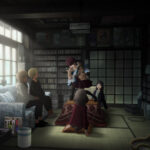 The five girls eventually settle down, learn each others habits and hangups, and do come together. There is drama here, but it’s not as heavy as the classic rock band anime NANA, for instance. Girls Band Cry remains generally lighthearted and while some situations can comes as a shock or take multiple episodes to resolve, the girls do eventually resolve them. The writing here is excellent. The personalities feel real. There’s some humor along the way, but it’s humor that fits in with the show instead of humor that is the show.
The five girls eventually settle down, learn each others habits and hangups, and do come together. There is drama here, but it’s not as heavy as the classic rock band anime NANA, for instance. Girls Band Cry remains generally lighthearted and while some situations can comes as a shock or take multiple episodes to resolve, the girls do eventually resolve them. The writing here is excellent. The personalities feel real. There’s some humor along the way, but it’s humor that fits in with the show instead of humor that is the show.
Animation and Music:
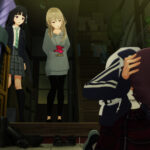 Girls Band Cry is a 3d CGI production, meaning most everything except the rare one off background character is done as computer animation. While the show generally lacks the overwhelmingly rich level of foreground and background detail something like a full blown Disney/Pixar movie has, Girls Band Cry does have its own strengths that become more apparent the more you watch. The show features a smooth, constant, 24 frames per second rate of animation. A lot of hand-drawn and CGI anime updates less frequently where Girls Band Cry updates the movements of its camera and characters every frame. In practice what this mean is every scene has something happening. Every character movement is smooth and detailed. From big sweeping gestures to the show’s frequent use of highly expressive facial reactions, everything is snappy and fluid in ways you might not expect from most 3d productions. Or from most traditional, hand-drawn anime for that matter.
Girls Band Cry is a 3d CGI production, meaning most everything except the rare one off background character is done as computer animation. While the show generally lacks the overwhelmingly rich level of foreground and background detail something like a full blown Disney/Pixar movie has, Girls Band Cry does have its own strengths that become more apparent the more you watch. The show features a smooth, constant, 24 frames per second rate of animation. A lot of hand-drawn and CGI anime updates less frequently where Girls Band Cry updates the movements of its camera and characters every frame. In practice what this mean is every scene has something happening. Every character movement is smooth and detailed. From big sweeping gestures to the show’s frequent use of highly expressive facial reactions, everything is snappy and fluid in ways you might not expect from most 3d productions. Or from most traditional, hand-drawn anime for that matter.
And this is surprising. At lot of 3d rendered shows skimp on this. Expressions often remained static and unchanging. Characters movements are sometimes jerky or or unnaturally stiff, especially when they aren’t the center of attention. Not so in Girls Band Cry. Its animation is actually really good! And consistently so! Which must have taken a ton of work all for a new, unknown, original anime based on nothing before it. There is no hundred issue manga funding this show.
 Finally, beyond the well-written characters and consistently good animation, there’s the rock music and the music sequences. Girls Band Cry’s music is influenced a lot by Nina’s experiences with bullying and feeling cut off. She sings about making tough choices. About feeling alone in crowds. About how patronizing it can be to tell someone to do their best but then tell them to fit in. And all this is held up by some of the very best music video type sequences in anime. There’s breathtakingly good motion capture of the girls playing instruments and singing. There’s fun, creative camera moves that pan, and snap and rotate and spin to the beat of the music.
Finally, beyond the well-written characters and consistently good animation, there’s the rock music and the music sequences. Girls Band Cry’s music is influenced a lot by Nina’s experiences with bullying and feeling cut off. She sings about making tough choices. About feeling alone in crowds. About how patronizing it can be to tell someone to do their best but then tell them to fit in. And all this is held up by some of the very best music video type sequences in anime. There’s breathtakingly good motion capture of the girls playing instruments and singing. There’s fun, creative camera moves that pan, and snap and rotate and spin to the beat of the music.
 There’s a variety of cool effects from raindrops hanging in the air to pretend glass walls shattering as they are referenced in the lyrics, to the momentary color inversions during one particularly awesome guitar solo. These sequences generally serve as rewarding ends to episodes. Some are high flying moments, others are yelling about injustices in the world through song, but they’re all brilliant showpieces of music and animation working hand in had.
There’s a variety of cool effects from raindrops hanging in the air to pretend glass walls shattering as they are referenced in the lyrics, to the momentary color inversions during one particularly awesome guitar solo. These sequences generally serve as rewarding ends to episodes. Some are high flying moments, others are yelling about injustices in the world through song, but they’re all brilliant showpieces of music and animation working hand in had.
All In All
 Girls Band Cry is about learning to be yourself, learning when to reject help and when to accept it, learning how to fit in with others and address their wants and their fears alongside your own. And it’s about these five girls supporting each other and combining their strengths to accomplish something bigger than their individual selves. It’s fun and entertaining rather than being heavy and depressing, but it is not a comedy-first show the likes of K-On! or Bocchi The Rock!. Aside from its showcase on-stage rock sequences, it doesn’t necessarily do anything never seen before. If you’ve watched NANA, K-On!, Bocchi the Rock, Ya Boy Kongming, and other music anime then you’ve seen a lot of the building blocks that Girls Band Cry draws upon, but it combines them with good character writing in fun ways that ended up making it one of my favorite anime of 2024.
Girls Band Cry is about learning to be yourself, learning when to reject help and when to accept it, learning how to fit in with others and address their wants and their fears alongside your own. And it’s about these five girls supporting each other and combining their strengths to accomplish something bigger than their individual selves. It’s fun and entertaining rather than being heavy and depressing, but it is not a comedy-first show the likes of K-On! or Bocchi The Rock!. Aside from its showcase on-stage rock sequences, it doesn’t necessarily do anything never seen before. If you’ve watched NANA, K-On!, Bocchi the Rock, Ya Boy Kongming, and other music anime then you’ve seen a lot of the building blocks that Girls Band Cry draws upon, but it combines them with good character writing in fun ways that ended up making it one of my favorite anime of 2024.
AniManga Picture Challenge 58: Hats
This week on the #AniMangaPictureChallenge we #AniMangaFoundIt some Hats from #anime and #manga to put on!
@BongoMcnulty Lupin the 3rd
@CT Howl's Moving Castle
@anicasts The Melancholy of Haruhi Suzumiya
@heinragas Super Dimensional Cavalry Southern Cross
@Ragashingo Mawaru Penguindrum
@lynnofthewired Baccano!
@fujiwara Kaguya-sama: Love Is War
@yellowjitsch Digimon Adventure
@closetweeb KiraKira☆Pretty Cure A La Mode
@heinragas Too Many Losing Heroines!
@Tatsumeg KonoSuba: An Explosion on This Wonderful World!
Thanks to everyone who submitted!
Anticipated Anime of 2025
2024 was a pretty good year for anime. There was a cool mix of returning favorites like Sound! Euphonium, Spice and Wolf, and Frieren: Beyond Journey’s end as well as some of off the wall oddball shows that weren’t afraid to be different. Brave Bang Bravern, Train to the End of the World, and Too Many Losing Heroines kept things fun and zany all year. Then there was Dandadan’s own form of insanity to round out the year.
Next year is looking pretty interesting, as well. My list of things to watch in 2025 includes some new entries in classic mecha franchises, continuations of great fantasy series, and a couple of new works that show promise. In no particular order, here’s the anime I looking forward to.
New Macross
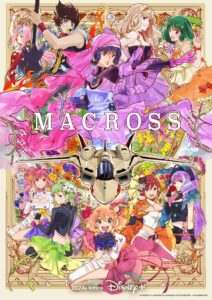 There’s a new entry coming in the Macross franchise. And it’s interesting for two reasons even though almost nothing is yet known about it.
There’s a new entry coming in the Macross franchise. And it’s interesting for two reasons even though almost nothing is yet known about it.
First, it was a big surprise to hear who this new show was coming from. As a 40+ year old franchise, multiple studios have worked on Macross over the years. A couple of the related shows were even made without authorization or input from the original creators! The most recent entires have been made by studio Satelight. But they’re going to be busy reviving their Aquarion franchise. That has seen production of the next Macross anime go to studio Sunrise! I put the exclamation mark there because although Sunrise has done everything from music idol Love Live to the jazz-filled sci-fi classic Cowboy Bebop, they are best known for making dozens of shows in the Gundam mecha franchise which is perhaps the closest thing to a competitor to Macross.
We don’t know who is directing this new Macross show. Or who is, very importantly, doing the music. We know almost nothing, so far. But having it developed by something of a rival studio is certainly interesting. And not necessarily a bad thing. I think Sunrise can be plenty capable of making a good Macross show. It’s going to come down to the leadership, tone, animation, and music. I mention music a second time because for various reasons from societal to technological, music has real power in the Macross universe. Music has literally stopped interstellar wars and pacified eldritch aliens, so which composer and singer(s) this new show features is perhaps more important than it would be for other sci-fi properties.
Second, when will this new Macross show will be set? Macross is fairly unique in that aside from a spattering of video games and maybe the odd side story or two, the mainline shows have all existed in a single continuity set from around a start in fictional 1999 to a little past a futuristic 2067. From a story perspective, each Macross show focuses on a new set of characters, but sometimes past events are referenced and past characters have even crossed over as importantly but minor characters in new shows. This means viewers don’t have to contend with a complicated mishmash of alternate universes and it simplifies questions as to where to start watching since there’s an actual beginning. Each new show is at least tangentially related to the ones that came before which I think of as a strength.
So, will this new entry move the timeline forward yet again? Will it be a sequel of a previous show? Or a side story set during the same time frame as an existing show? Or might it break tradition and be the first true alternate universe show? If I had my way, it would be a show set 10+ years forward of Macross Delta’s 2067 and again feature an entirely new set of characters. I’d also accept a continuation of my favorite entry, Macross Frontier. There’s one big plot thread left hanging there that would be great to finally wrap up. I don’t really want an alternate timeline. Leave that to Gundam and its myriad of disconnected yet annoyingly similar stories. (I’m look at you all you Char-masked villains!)
But no matter what happens, Macross is awesome and unique and I can’t wait to hear more about this new entry.
The Apothecary Diaries season 2
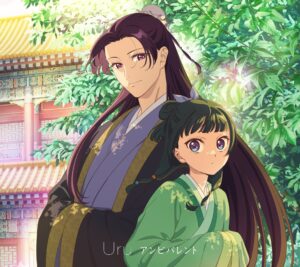 The first season of The Apothecary Diaries set in ancient China saw teenage apothecary and amateur herbalist Maomao be kidnapped and brought to work at the royal court. Through a mixture of accumulated knowledge, practical common sense, an occasional temper, and a bit of a devious streak, Maomao began fixing problems and solving mysteries among royal staff and concubines alike.
The first season of The Apothecary Diaries set in ancient China saw teenage apothecary and amateur herbalist Maomao be kidnapped and brought to work at the royal court. Through a mixture of accumulated knowledge, practical common sense, an occasional temper, and a bit of a devious streak, Maomao began fixing problems and solving mysteries among royal staff and concubines alike.
A bit of a goofball who even enjoys lightly poisoning herself to figure out the best way to counteract new poisons, Maomao found herself dragged into issues ranging from malnutrition to aphrodisiacs to novel forms of court politics and murder! Slowly, problem by problem, she grew her respect and reputation, much to her own annoyance. Just as often as not she’d rather these nobles leave her alone and solve their own problems, but her honest and inquisitive nature wouldn’t let her ignore the plights of others for long and she’d soon reluctantly get wrapped up in the intrigues herself.
The show was a lot of fun even as Maomao herself was kinda a weirdo. The upcoming second season promises to dig into more court intrigue and even more into Maomao’s secretive past that she is just beginning to uncover!
Ghost in the Shell by Science Saru
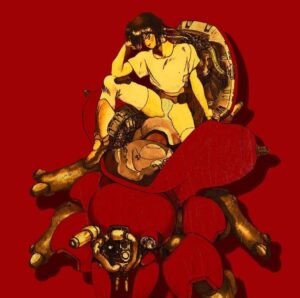 Ghost in the Shell is always a bigger franchise than I give it credit for. It’s got two early movies. The three-ish seasons of the excellent Stand Alone Complex anime. The Ghost in the Shell: Arise mini series which I love and others love to hate. And the much maligned live action movie which was pretty terrible because it failed to understand the philosophy of Ghost in the Shell. (And not because of its casting choices, fight me!)
Ghost in the Shell is always a bigger franchise than I give it credit for. It’s got two early movies. The three-ish seasons of the excellent Stand Alone Complex anime. The Ghost in the Shell: Arise mini series which I love and others love to hate. And the much maligned live action movie which was pretty terrible because it failed to understand the philosophy of Ghost in the Shell. (And not because of its casting choices, fight me!)
This new entry by the always a bit odd production studio Science Saru has very few details out right now, but the initial teaser seemed to very clearly focus on the original manga leading some to speculate this will be a faithful retelling of those stories.
Even though I kinda don’t like roughly half of the entires of this franchise, it’s always interesting to see a new adaptation on the horizon. The core world and cyberpunk aspects of Ghost in the Shell are very solid. It all comes down to what is done with it this time. I’m especially interested to see what they do with the art given all the manga panels they were showing in the teaser and the retro bit of art Science Saru put out.
Witch Hat Atelier
 To be honest, I don’t know a ton about this upcoming fantasy series. It seems to be about magic, who has access to it and who controls it, and what good or bad is done with it.
To be honest, I don’t know a ton about this upcoming fantasy series. It seems to be about magic, who has access to it and who controls it, and what good or bad is done with it.
The trailer made it feel like something of a magical coming of age story as our young heroine maybe attempted to perform magic before being chased by those who didn’t want her to do so and then being saved by someone who could teach her secrets locked away or forgotten by the modern magical world. Something like that…
What I do know is people seem really excited about this show. I’ve seen more than a few say it is one of a big three of modern fantasy classics along with, I think, Jobless Reincarnation and Frieren: Beyond Joureny’s End. The former two are outstanding in their own ways (with Jobless Reincarnation adding a big dose of problematic just for kicks)… so I have high hopes for this one as well.
Mobile Suit Gundam GQuuuuuuX
 Gundam is not my favorite mecha franchise, that would be Macross from up above. I’ve tried getting into Gundam over and over and it has never really stuck. Something about a combination of its age, weird plots, overuse of heavily repeated themes and callback similarities between series, and the pile of one off universes disconnected from all the others has me slightly negative on the franchise as a whole.
Gundam is not my favorite mecha franchise, that would be Macross from up above. I’ve tried getting into Gundam over and over and it has never really stuck. Something about a combination of its age, weird plots, overuse of heavily repeated themes and callback similarities between series, and the pile of one off universes disconnected from all the others has me slightly negative on the franchise as a whole.
That said, I enjoyed 2022’s The Witch from Mercury even if it was a bit rushed in places. This new series, GQuuuuuuX, so far seems intriguing with a second go at a main female protagonist and a weirdly named main mech (which may or may not actually be a Gundam) that is initially involved in combat for sport rather than for war. War seems to be coming, though. It’s as much a core part of Gundam as music is for Macross.
Really the whole package here has me intrigued. It could totally be another entry I can’t stand with too many reused tropes from past Gundam anime, but there’s enough here for me to give it a real chance. I look forward to learning more and I hope it turns out of be some cool robot sci-fi I can really get behind.
Madoka Magica Walpurgisnacht Rising
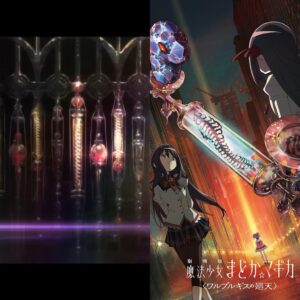 Madoka Magica is a landmark anime. It takes traditional magical girl shows which typically feature one or more girls with magical abilities fighting against evil using the powers of hope and friendship. Madoka turned the whole concept on its head in the most devious way and then did something even neater. It takes its subversive messages of despair overwhelming hope and brings them back around to the beginning. Where it seemed to be an unrelenting critical deconstruction railing against traditional magical girl shows it actually executed another perfect flip to become the best and truest of them all.
Madoka Magica is a landmark anime. It takes traditional magical girl shows which typically feature one or more girls with magical abilities fighting against evil using the powers of hope and friendship. Madoka turned the whole concept on its head in the most devious way and then did something even neater. It takes its subversive messages of despair overwhelming hope and brings them back around to the beginning. Where it seemed to be an unrelenting critical deconstruction railing against traditional magical girl shows it actually executed another perfect flip to become the best and truest of them all.
Then they did the 3rd movie, Rebellion. (The first two were just recaps of the anime). Some, like me, loved it. It could be argued that it steadfastly and honestly follows the thought processes and inclinations of some of the core characters to their logical and impressively destructive conclusions. Others, also like me, think it messed with perfection. That it undid an extremely well earned and meaningful ending.
Yes, I am of both opinions! But while Rebellion is divisive, it cannot be denied that it was an amazing production. Its pacing and animation and music were all top notch. This new movie looks to up things yet again. From what we’ve seen in trailers, it looks and sounds fantastic. There’s mysteries and intrigue and “why the heck is that person there?!” and “oh no, what does that mean?!!” for big fans like me to puzzle over.
Will this new movie be accepted? Will it upend things yet again? Will it become a core part of the show’s story? Will it be something that some love and some hate? Will it be a complete failure rejected and forgotten? Nobody knows! The chance to see a favorite work soar high or come crashing down is one of the big reasons for me to anticipate this one.
Lycoris Recoil Shorts & Season 2
 In modern day Japan, the government rounds up orphan girls and trains them as deadly peacekeeping assassins who preemptively eliminate crime and terrorism before they can be carried out. These “Lycoris” do their deadly work disguised as everyday schoolgirls. The original show followed two such Lycoris, the joyfully hyperactive and endlessly helpful Chisato Nishikigi who has reflexes so good you literally cannot shoot her, and Takina Inoue, a highly skilled, no-nonsense Lycoris who was demoted to be Chisato’s partner because of her inflexible nature.
In modern day Japan, the government rounds up orphan girls and trains them as deadly peacekeeping assassins who preemptively eliminate crime and terrorism before they can be carried out. These “Lycoris” do their deadly work disguised as everyday schoolgirls. The original show followed two such Lycoris, the joyfully hyperactive and endlessly helpful Chisato Nishikigi who has reflexes so good you literally cannot shoot her, and Takina Inoue, a highly skilled, no-nonsense Lycoris who was demoted to be Chisato’s partner because of her inflexible nature.
The show thrived on Chisato’s antics, her kindness, her incredible close combat gun-fu, her imperative to live each day to its fullest, and her unshakable philosophy of ultra-aggressive pacifism that saw her outright refuse to kill even the baddest bad guy, but at the same time gave her full leeway to shoot them with painful non-lethal bullets so often that they’d have no choice but to rethink their actions. Add in Takina as the straight-laced buddy cop Chiasto got to play off of and a wonky, Joker-like villain to stir up trouble and you got a surprisingly excellent show that came out of nowhere!
This year, we should be getting some new shorts that follow the continued activities of Chisato and Takina. Maybe they’ll still be defying their covert organization by providing problem solving services in Hawaii. Maybe they’ll be back at their little LycoReco cafe in Japan where they’d pick up odd jobs helping manga artists gain inspiration or helping police detectives solve cases. Whatever they do, it’s bound to be fun. There’s also talk of a full second season that I think is more or less confirmed but maybe not officially announced. That’ll be great too!
Symphogear Next
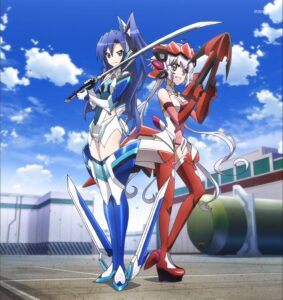 Symphogear is kinda a crazy concept. Take your typical magical girl anime, but instead of having these high school girls gain superpowers through magical means, have those powers come through the power of songs in combination with a mixture of ancient human and alien technology. These heroines literally sing out loud during battles to power their fights against evil biological weapons spawned from another dimension not to mention the bad guys who would wield such abominations against humanity for their own gain.
Symphogear is kinda a crazy concept. Take your typical magical girl anime, but instead of having these high school girls gain superpowers through magical means, have those powers come through the power of songs in combination with a mixture of ancient human and alien technology. These heroines literally sing out loud during battles to power their fights against evil biological weapons spawned from another dimension not to mention the bad guys who would wield such abominations against humanity for their own gain.
The show has over 100 character songs, terrific action scenes, and a good helping of heart. Those things are what make Symphogear the outstanding anime it is. It’s one of those shows where everything from the character designs to the villains to the fights are all just a bit over the top in the best ways.
And now, after the solid, story-ending conclusion of its 5th season, it is getting… something new. And nobody knows what just yet. There’s some theories of a prequel show. Others of a sequel film. Like several of the other shows, I don’t know what’s coming, but I’m excited to see what it is!
Medalist
 Sports anime can occasionally be awesome. I don’t know much about this one other than it is about a young skater dreaming of someday competing in the olympics and her coach who helps her train for ice dancing competitions. Or something. The trailers have seemed interesting enough. I’m hoping this will be a surprise standout.
Sports anime can occasionally be awesome. I don’t know much about this one other than it is about a young skater dreaming of someday competing in the olympics and her coach who helps her train for ice dancing competitions. Or something. The trailers have seemed interesting enough. I’m hoping this will be a surprise standout.
The anime has a relatively young studio working on it, but has screenwriter Jukki Hanada famous for some great anime on board. He’s worked on the stories for some of my favorites including A Place Further than the Universe, Sound! Euphonium, Steins;Gate, and Girls Band Cry. This could be a good one if the art and animation can keep up with what will hopefully be a good story.
Frieren: Beyond Journey’s End Season 2
 The first season of this anime was outstanding. The show starts with the nearly ageless elven mage Frieren returning home as a member of the Hero’s Party of adventurers who defeated the demon king and made the world much safer for mankind. And then it explores what happens next. Frieren’s friends grow old and die while she stays the same. The world advances. New threats emerge. New friends, some related to those of her past, join her on a new adventure that retraces the footsteps and memories of the one she went on previously.
The first season of this anime was outstanding. The show starts with the nearly ageless elven mage Frieren returning home as a member of the Hero’s Party of adventurers who defeated the demon king and made the world much safer for mankind. And then it explores what happens next. Frieren’s friends grow old and die while she stays the same. The world advances. New threats emerge. New friends, some related to those of her past, join her on a new adventure that retraces the footsteps and memories of the one she went on previously.
The show mixes action, kindness, nostalgia, magic, great animation and music, amazing characters, and a bit of humor all to perfect effect. Part of its appeal is its brilliance in its simplicity. And now we know it is getting a second season. And while it’s not my absolute favorite anime of all time, it’s right near the top and deserves all the praise that has been heaped on it.
Bang Brave Bang Bravern
 Easily the most surprising and standout anime in the Winter 2024 season, Bang Brave Bang Bravern has me laughing out loud every week with its wacky, save the world mecha hijinks.
Easily the most surprising and standout anime in the Winter 2024 season, Bang Brave Bang Bravern has me laughing out loud every week with its wacky, save the world mecha hijinks.
Bang Braven, I guess that’s what I’ll call it, is different in tone from a serious Gundam or Macross, and while self-aware, it’s also not an SSSS.Gridman style show, either. Even though it’s dealing with largely real-world military forces (well, until it doesn’t) the show I think it feels closest to is actually Tengen Toppa Gurren Lagann. I doubt this will have a tournament arc like Gurren Lagann did, but they share a similar sort of energy, excitement, and humor.
Sometime around the modern day, American and Japanese forces are having a joint military exercise around Hawaii. Everything from aircraft carriers to ground forces to American Titanostrider mechs and Japanese equivalents are simulating a joint attack on a fortified beachhead.
And then, aliens attack.
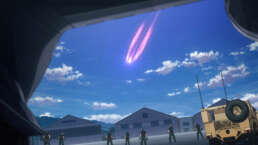

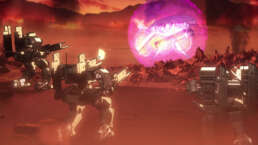
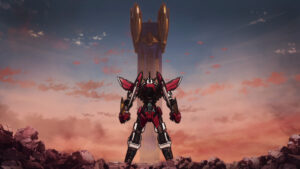 Even our best soldiers and most powerful machines are all but useless against the shielded alien mechs that descend from space and soon blanket the entire world similar to Independence Day. The situation looks all but lost for our heroes in Hawaii, but then, at the last moment, a red, blue, and white talking mech saves the day and takes in one of the Japanese mecha pilots as its pilot.
Even our best soldiers and most powerful machines are all but useless against the shielded alien mechs that descend from space and soon blanket the entire world similar to Independence Day. The situation looks all but lost for our heroes in Hawaii, but then, at the last moment, a red, blue, and white talking mech saves the day and takes in one of the Japanese mecha pilots as its pilot.
This new mech is named Bravern. Bravern is loud. Bravern is bombastic. Bravern encourages his new pilot, Isami Ao, yell out the names of super attacks along with him. With Bravern’s help, the surviving joint forces are able to push back the aliens around Hawaii. And then things get even crazier.
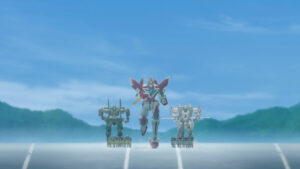 Unlike most other mecha shows, where the gundams, or similar mechs, are just stationary machines without their pilots, Bravern himself remains very much a character after the battle ends. Though Bravern’s head is multiple the size of an entire human, he participates in strategy meetings. He leads the joint forces in exercise routines that include runs and pushups for the humans and their machines. He leads training courses on, complete with an overhead projector, showing the joint forces how to overwhelm the enemy’s shields. Bravern is such a fun character he pretty drives the show much like Kamina did for Gurren Lagann.
Unlike most other mecha shows, where the gundams, or similar mechs, are just stationary machines without their pilots, Bravern himself remains very much a character after the battle ends. Though Bravern’s head is multiple the size of an entire human, he participates in strategy meetings. He leads the joint forces in exercise routines that include runs and pushups for the humans and their machines. He leads training courses on, complete with an overhead projector, showing the joint forces how to overwhelm the enemy’s shields. Bravern is such a fun character he pretty drives the show much like Kamina did for Gurren Lagann.
 That doesn’t mean we don’t have other good characters. Pilot Isami Ao has so far been a reluctant pilot of the brash Bravern. There is some bond between them that hasn’t been fully explored yet. There’s also Lewis Smith, one of the American pilots who wishes he could operate Bravern, but Bravern will not let him for some reason. Again, something about that bond between Bravern and Isami. Maybe some sort of past battles they shared in space that Isami has since forgotten about? Minor characters include the joint forces commander. And the airborne command and control operators who direct our heroes into battle.
That doesn’t mean we don’t have other good characters. Pilot Isami Ao has so far been a reluctant pilot of the brash Bravern. There is some bond between them that hasn’t been fully explored yet. There’s also Lewis Smith, one of the American pilots who wishes he could operate Bravern, but Bravern will not let him for some reason. Again, something about that bond between Bravern and Isami. Maybe some sort of past battles they shared in space that Isami has since forgotten about? Minor characters include the joint forces commander. And the airborne command and control operators who direct our heroes into battle.
Whatever secrets the show is holding on to for now, it is just hilarious and a joy to watch. And not just for the humor that makes it good. This week’s episode had a touching moment where a bunch of the soldiers and technicians Isami helped save in the opening battle got to thank him and buy him drinks. Lewis Smith is having to deal with not being the superhero pilot after being rejected by Bravern. We also got a glimpse of the allied forces’ first counterattack location, and it was kinda gut wrenching to see these soldiers and technicians in shock over the battering their homelands have taken.
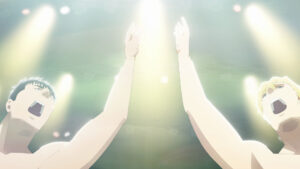 The show is not going to instantly appeal to everyone. It is fairly silly and tongue in cheek despite some of its more serious, straightforward military trappings. But for anyone willing to have a bit of knowing fun thrown into their serious military mecha show, there’s nothing in recent memory that can top this.
The show is not going to instantly appeal to everyone. It is fairly silly and tongue in cheek despite some of its more serious, straightforward military trappings. But for anyone willing to have a bit of knowing fun thrown into their serious military mecha show, there’s nothing in recent memory that can top this.
Also, the ending credits of each episode. Neither words nor a single image can do them justice. Just… wow.
2022 Was A Great Year for Anime
2022 was a great year for anime. I don’t think I’ve experience a year this good since the phenomenal 2018 which gave us shows like:
- A Place Further Than The Universe
- Violet Evergarden
- Revue Starlight
- Rascal Does Not Dream of Bunny Girl Senpai
- SSSS.Gridman
- Maquia: When the Promised Flower Blooms
What 2022 gave us was both some wildly popular mainstream shows, and a fair number of excellent shows that came in out of nowhere or were just plain happy to exist off the beaten path. One thing that made me extra happy this year were the number of shows centered around music and personal creativity.
Here’s the shows I enjoyed most in 2022:
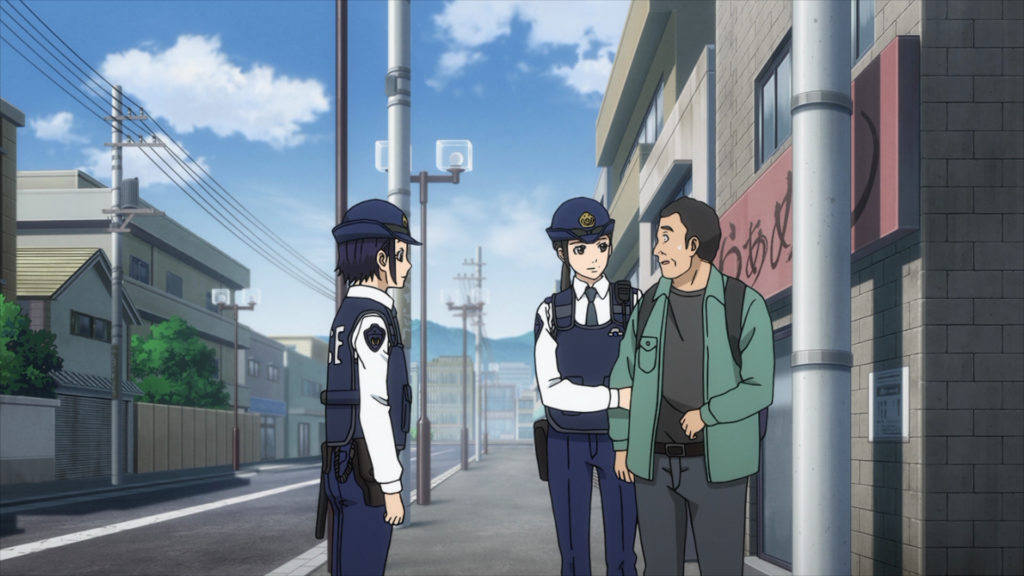 Police in a Pod – This police slice of life anime that sprung from the mind of a former real life Japanese patrol officer somehow manages to be both amusing and all too real. It follows the lives and happenings surrounding two patrol officers working out of a small neighborhood police station and features a wide variety of on the job and off the job situations the two must tackle.
Police in a Pod – This police slice of life anime that sprung from the mind of a former real life Japanese patrol officer somehow manages to be both amusing and all too real. It follows the lives and happenings surrounding two patrol officers working out of a small neighborhood police station and features a wide variety of on the job and off the job situations the two must tackle.
The show mixes the joys of rescuing victims of abuse and catching criminals who think they are too clever to be caught with the real challenges and hardships officers go through in an effort to live their lives and keep their sanity while working in a system that doesn’t always have their best interests in mind. Everything from simple patrols, to search and rescues, to responding to troubling calls like domestic violence and suicides is represented here. The dialogue is witty without being annoying or “Marvel snappy”. And the institutional knowledge on display is fabulous, even if the animation budget was a size or so too small.
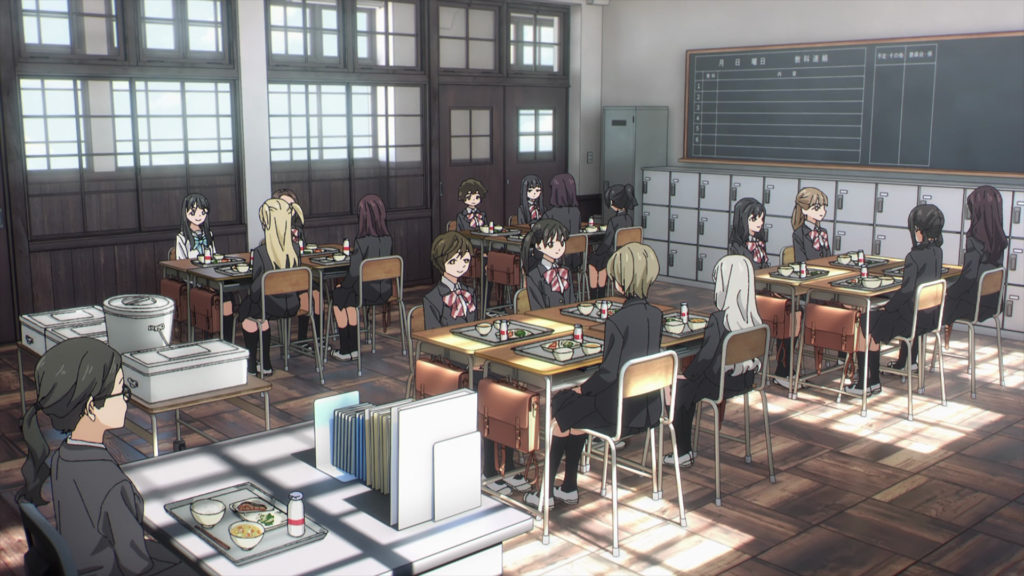 Akebi’s Sailor Uniform – As discussed at length in my review, this show is a modern classic. It’s an animator’s anime that takes joy in depicting the motions and emotions inherent in young teenager Komichi Akebi’s life as she goes to school, plays sports, and makes lots and lots of friends.
Akebi’s Sailor Uniform – As discussed at length in my review, this show is a modern classic. It’s an animator’s anime that takes joy in depicting the motions and emotions inherent in young teenager Komichi Akebi’s life as she goes to school, plays sports, and makes lots and lots of friends.
While it may never be as outwardly flashy as the effects-heavy combat animations in popular action anime, the artwork and artistry this show has to offer is, in many ways, second to none. The way the show combines that with a full class of interesting characters and a great soundtrack makes me think it will long be remembered.
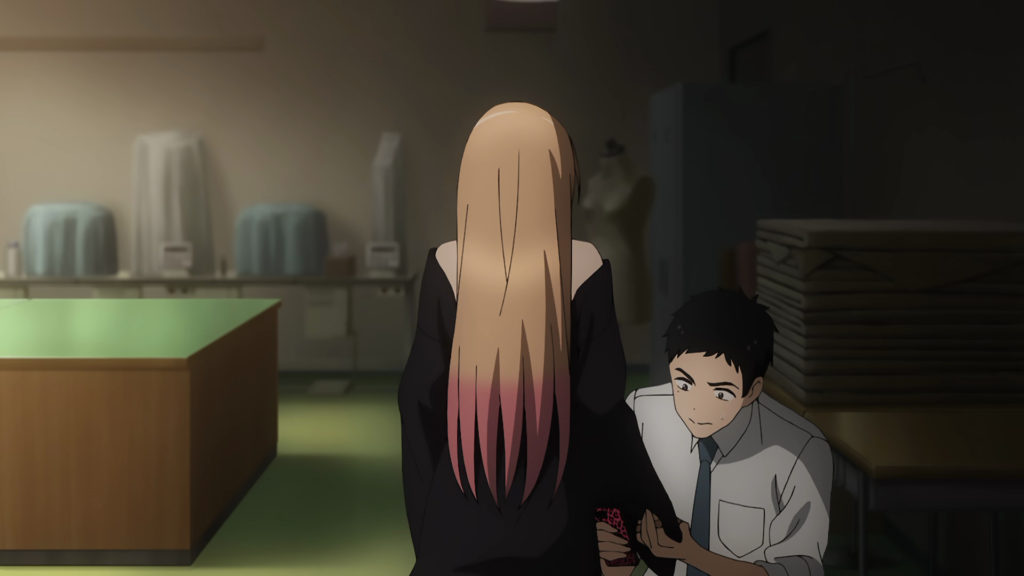 My Dress-up Darling – Cosplay, dressing up as your favorite characters from tv or games or movies, is a popular pass time. But also one that is expensive and takes a good deal of skill to pull off successfully. Energetic, outgoing hipster Marin Kitagawa knows this all too well when her efforts to design a costume in an effort to become her favorite game character fails miserably. But then she meets the reserved Wakana Gojo at her high school one evening. His talents at designing outfits for tiny hina dolls for his family business sees him get roped in to be her cosplay costume designer.
My Dress-up Darling – Cosplay, dressing up as your favorite characters from tv or games or movies, is a popular pass time. But also one that is expensive and takes a good deal of skill to pull off successfully. Energetic, outgoing hipster Marin Kitagawa knows this all too well when her efforts to design a costume in an effort to become her favorite game character fails miserably. But then she meets the reserved Wakana Gojo at her high school one evening. His talents at designing outfits for tiny hina dolls for his family business sees him get roped in to be her cosplay costume designer.
What follows is a remarkably wholesome budding romance between these two lead characters, even though Marin’s greatest wish is to dress up as some surprisingly provocative figures from her favorite games and tv series. Respect, recognition of effort, and acknowledging one another’s boundaries and dreams play just as large a role in this romance anime as the crazy, and often revealing, costumes Marin commissions from Wakana.
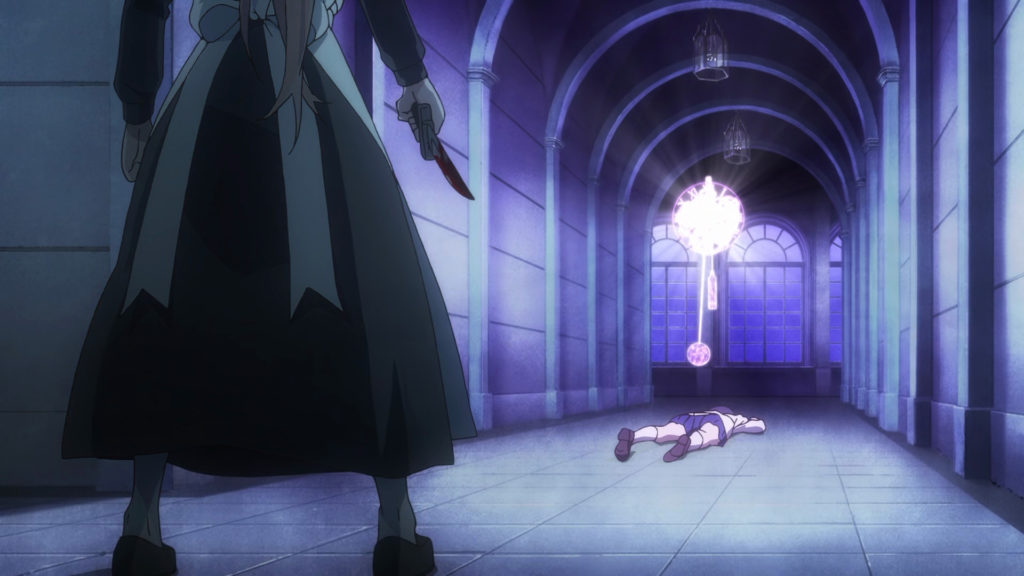 The Executioner and Her Way of Life – There’s a genre of anime called “Isekai”, a word which means “different world”, which revolve around the core premise of a normal guy or girl from our modern world being transported to some kind of alternate fantasy world where they often gain impossible abilities and become the hero destined to save the day. There’s a lot of these. So many that copy cats and uninspired efforts sometimes give bad name to the good examples of the genre.
The Executioner and Her Way of Life – There’s a genre of anime called “Isekai”, a word which means “different world”, which revolve around the core premise of a normal guy or girl from our modern world being transported to some kind of alternate fantasy world where they often gain impossible abilities and become the hero destined to save the day. There’s a lot of these. So many that copy cats and uninspired efforts sometimes give bad name to the good examples of the genre.
This show is one of those good ones mostly for the way it flips the concept on its head. In this particular fantasy world, people from our modern day Japan get summoned across dimensions and gain great magical powers, but those powers are just as often unbelievably dangerous as they are helpful. So, there exists a whole sect devoted to finding these would be heroes/villains/natural disasters and ending them before they can become a threat to themselves or others.
Our main character, priestess Menou, is tasked with killing newly transported innocent schoolgirl Akari Tokitō whose new innate powers of time manipulation are so dangerous they threaten everyone and everything. There’s just one problem: Akari is so powerful that she cannot be killed. Even a successful surprise assassination from Menou early in the series just sees Akari’s time powers turn back the clock on her own body so her fatal injuries are undone.
In order to save the world, these two characters come to form an unlikely friendship based on the mutual desire to find a way to kill Akari before her powers spiral out of control and break time itself. The show features fun characters and a good plot twist or two that make it all worth watching.
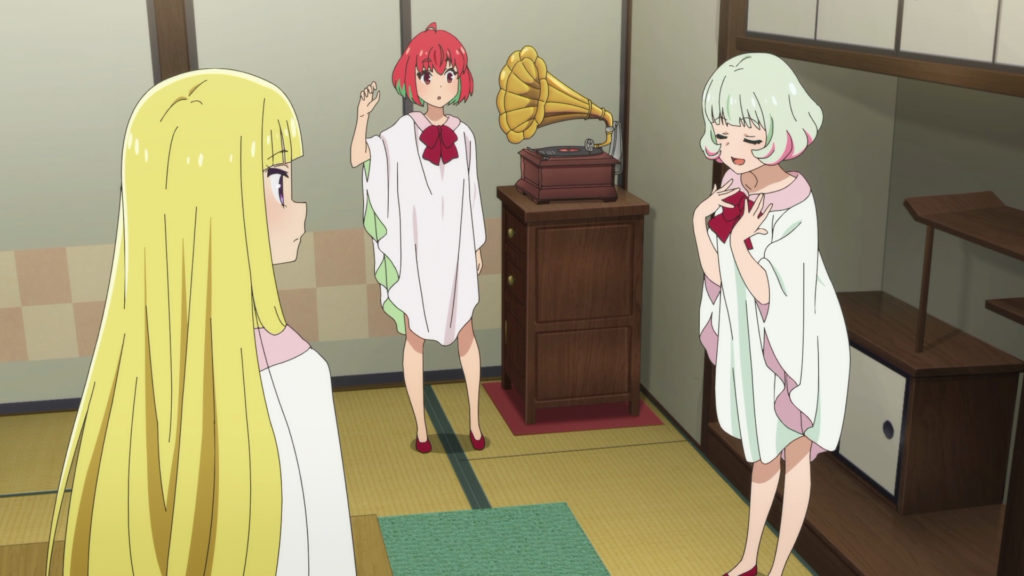 Healer Girl – In our modern day, the science of musical healing is beginning to join more traditional medical techniques for treating patients. We follow three up and coming musical healers as they apprentice at a local clinic and seek to earn their professional licenses.
Healer Girl – In our modern day, the science of musical healing is beginning to join more traditional medical techniques for treating patients. We follow three up and coming musical healers as they apprentice at a local clinic and seek to earn their professional licenses.
This show is fun, colorful, and surprisingly musical. The three main character, of course, sing to do things like heal minor injuries or support surgeons during surgery, but singing is so innately a part of their lives that they do it all the time. This leads to fun segments of the girls singing out their life-long motivations or singing out technical musical terms for an upcoming exam while they clean their clinic. While it doesn’t have the biggest budget and there’s no particular conflict to keep you glued to your tv, this show provided me with enough wholesome musical fun to keep me watching week to week.
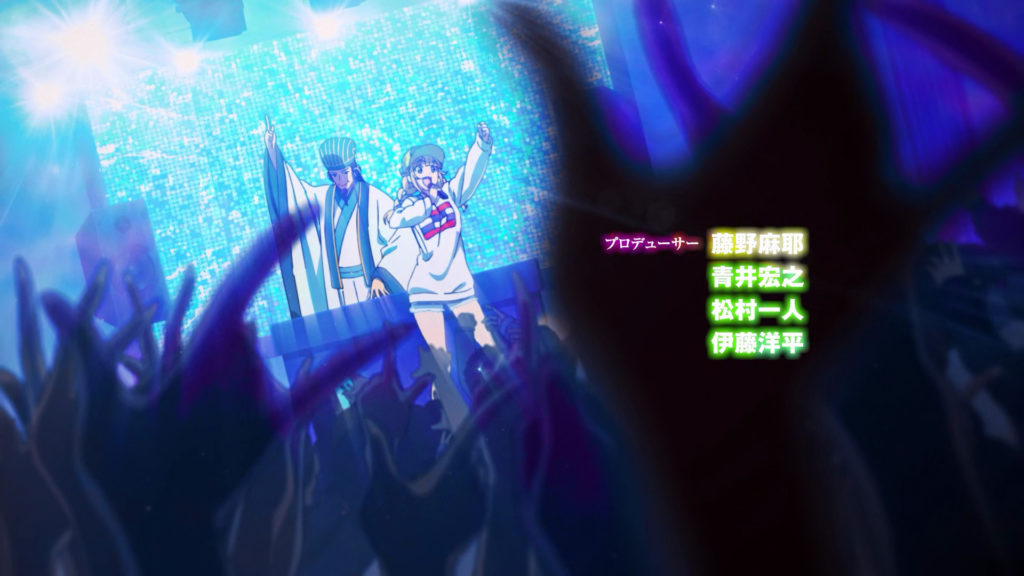 Ya Boy Kongming – Speaking of music, this show with its concept of ancient Chinese military strategist Zhuge Liang Kongming reawakening in modern day Japan in order to devise clever marketing strategies for an unknown club singer named Eiko Tsukimi just seemed far too odd for people to give it a chance. And then everyone saw it’s glorious opening with it’s crazy, upbeat music and outstandingly artsy animation and we were all hooked.
Ya Boy Kongming – Speaking of music, this show with its concept of ancient Chinese military strategist Zhuge Liang Kongming reawakening in modern day Japan in order to devise clever marketing strategies for an unknown club singer named Eiko Tsukimi just seemed far too odd for people to give it a chance. And then everyone saw it’s glorious opening with it’s crazy, upbeat music and outstandingly artsy animation and we were all hooked.
Spectacular, fortune-changing opening aside, this show kept its audience around by being a surprisingly well put together story of an unknown talent climbing the music charts to starhood while making friends and changing lives for the better along the way. If you liked Carole & Tuesday, you’ll like this too. It’s got music. It’s got heart. It’s got better art than I initially expected. It’s got one of the best anime openings of all time. What more do you really need?!
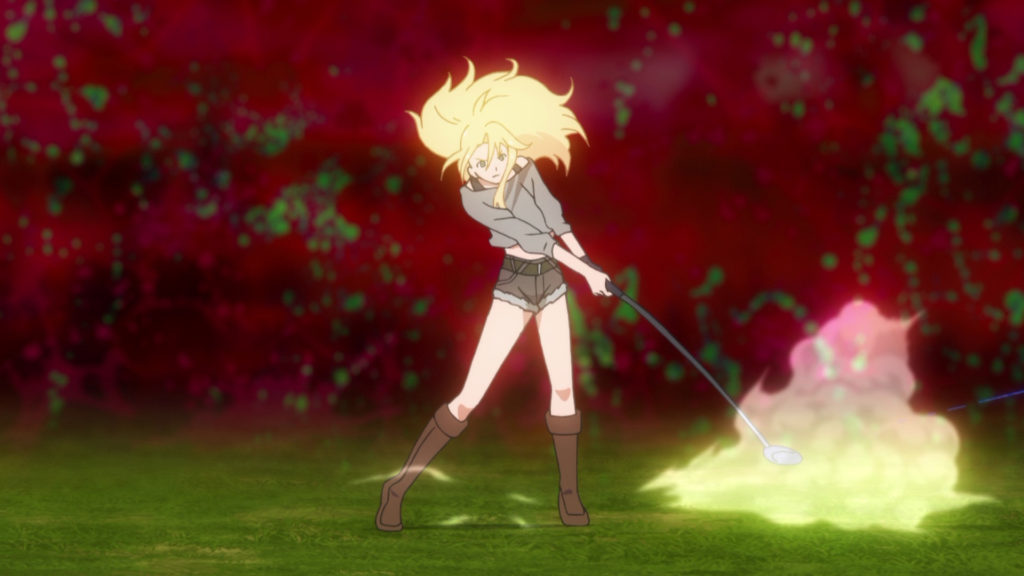 Birdie Wing: Golf Girls’ Story – Imagine the perfect golf anime. Stunningly detailed lakes and sand traps and fairways and brilliant blue skies. Extremely well animated swings. Intense on course rivalries. That perfect clinking sound of sinking a long, difficult putt. Now… mix in a hefty does of the extremely over the top gambling anime Kakegurui and add a dash of… I don’t know, something insane like Kill la Kill or Gurren Lagann… then stir vigorously. That’ll just about get you to Birdie Wing.
Birdie Wing: Golf Girls’ Story – Imagine the perfect golf anime. Stunningly detailed lakes and sand traps and fairways and brilliant blue skies. Extremely well animated swings. Intense on course rivalries. That perfect clinking sound of sinking a long, difficult putt. Now… mix in a hefty does of the extremely over the top gambling anime Kakegurui and add a dash of… I don’t know, something insane like Kill la Kill or Gurren Lagann… then stir vigorously. That’ll just about get you to Birdie Wing.
This is a crazy story of a female golfer named Eve who yells out the names of powerful secret swing techniques taught to her by a departed golf master. She plays illicit rounds of golf against wealthy, overconfident would-be rivals who bet against her often in opposition to the wishes of the cutthroat international golf mafia. She does this so she can humiliate everyone involved and pocket large sums of money so she can continue to protect her bar where she and her friends take care of a needy group of orphans. All of which goes well until Eve finally meets a true rival in the endlessly calm and collected Aoi Amawashi who herself is the offspring of two golfing legends. Aoi has become enslaved in corporate sponsorships thanks to her overbearing CEO of a mother and she too is in the sights of the golf mafia. Eve and Aoi become infatuated with each other’s skill and personality the first time they meet and soon join forces to take down the golf mafia and the invasive corporate powers ruining their lives.
Uh… yeah, this show is out of its mind. Which probably makes it the best possible golf anime that can be made!
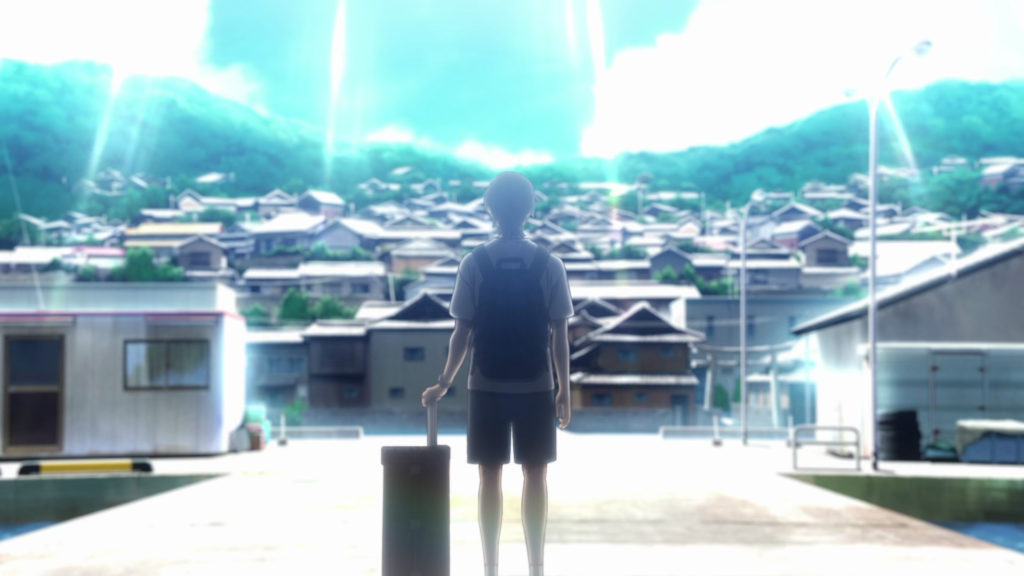 Summer Time Rendering – High school aged Shinpei Ajiro is returning home to his small Japanese island town in order to attend the funeral of his similarly aged adoptive sister Ushio Kofune who recently died in a drowning accident.
Summer Time Rendering – High school aged Shinpei Ajiro is returning home to his small Japanese island town in order to attend the funeral of his similarly aged adoptive sister Ushio Kofune who recently died in a drowning accident.
Except, maybe it was no accident. And maybe the supernatural was involved. By the end of the first episode Shinpei ends up getting murdered only to awaken a few days earlier back on the ferry he rode in on… and the expansive, intersting story goes from there. The animation is excellent. The characters are great. The story is well plotted. And I’m not gonna talk about any more of it… Just go watch it, already!
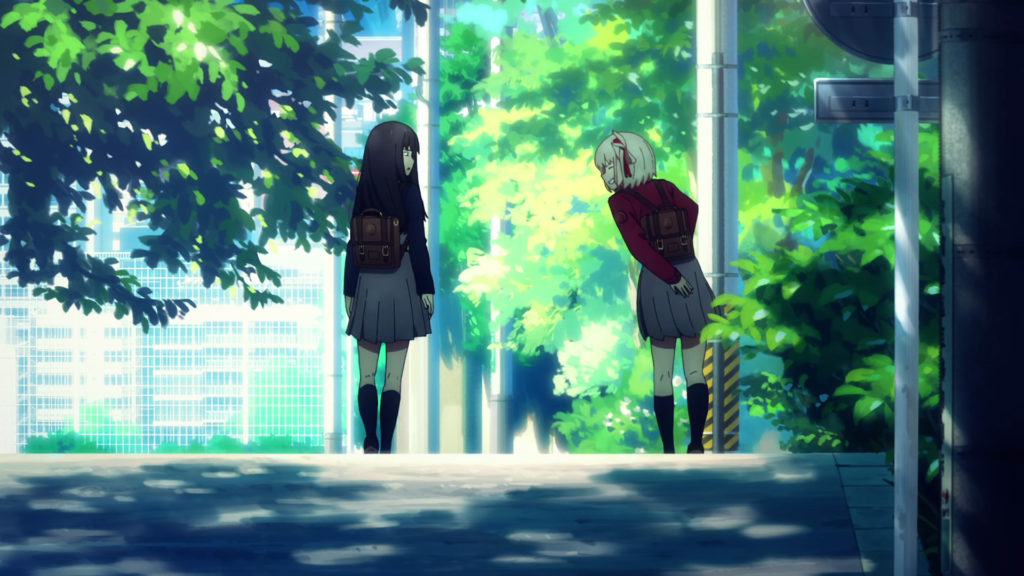 Lycoris Recoil – Modern day Japan is a nice safe place because it is a country of nice, caring people. Well, that, and because the government runs a miniature army of “Lycoris”, highly trained assassins disguised as schoolgirls, who are constantly on undercover patrols killing any and all bad guys before they can threaten anyone.
Lycoris Recoil – Modern day Japan is a nice safe place because it is a country of nice, caring people. Well, that, and because the government runs a miniature army of “Lycoris”, highly trained assassins disguised as schoolgirls, who are constantly on undercover patrols killing any and all bad guys before they can threaten anyone.
The show follows top Lycoris Chisato Nishikigi and her recently demoted partner Takina Inoue as they work out of a small cafe and help everyday people solve larger than life problems. Chisato is what made this anime great. She is upbeat, excitable, and very nearly hyperactive. Her refreshing outlook on life sees her try to fully enjoy her each and every moment but also sees her unwilling to kill because she does not wish to take similar precious moments away from anyone… even bad guys. It’s a philosophy she spends the entire show imparting on her new, grumpy, by the book protégé, Takina.
Highly enjoyable characterizations and some excellent animation made this a must watch series, even if the entire concept was a bit odd.
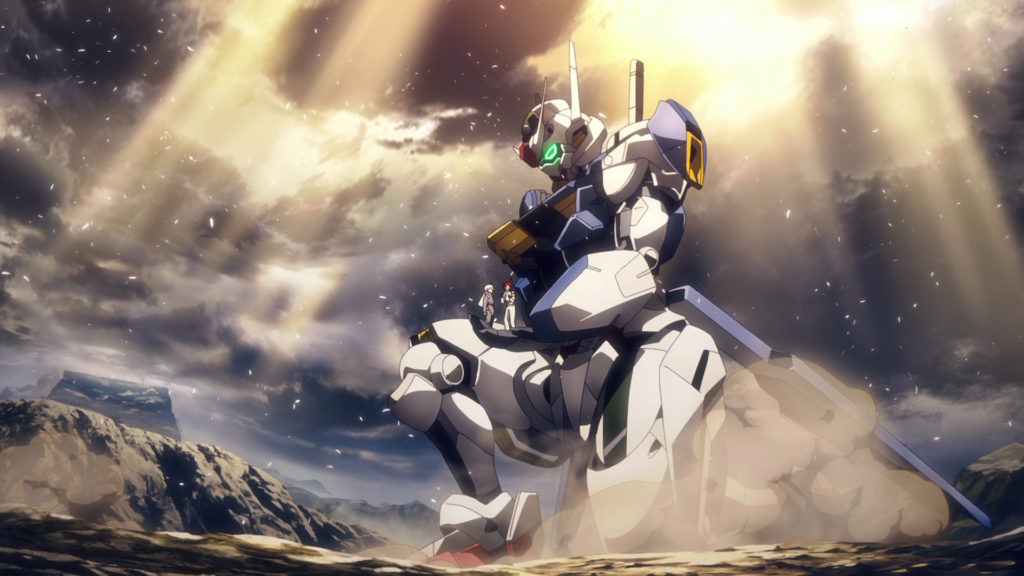 Mobile Suit Gundam: The Witch from Mercury – Marketed as the first of the long running Gundam series to feature a female lead character, Witch From Mercury is not your typical Gundam show in more ways than one. It starts with a hard hitting prologue and then switches gears to something of a space high school setting where our lead character, Suletta Mercury, seems like the outer space version of a country bumpkin dropped into an odd mix of petty school cliques, intense Earthian vs Spacian economic rivalries, and high stakes corporate politics. Oh, and Suletta and her mother at first seem to know nothing of the tragic prologue they were both very much a part of!
Mobile Suit Gundam: The Witch from Mercury – Marketed as the first of the long running Gundam series to feature a female lead character, Witch From Mercury is not your typical Gundam show in more ways than one. It starts with a hard hitting prologue and then switches gears to something of a space high school setting where our lead character, Suletta Mercury, seems like the outer space version of a country bumpkin dropped into an odd mix of petty school cliques, intense Earthian vs Spacian economic rivalries, and high stakes corporate politics. Oh, and Suletta and her mother at first seem to know nothing of the tragic prologue they were both very much a part of!
This show features awesome giant robot fights, a suspiciously idealistic main character, and a plot that seems to know what it’s doing but at the same time plays its cards very close to its chest. It’s up to the viewer to pick out the little discrepancies strewn about the episodes that makes this outwardly happy show into something much more intense and horrifying that it first appears.
Admittedly, this show is only at its halfway point, and it could totally take a bad, unsatisfying turn in its second half this Spring. But, for now at least, it’s a hands down smashing example of a show that trusts its audience to dig into its story and find the hints that it is constantly dropping. I love that kind of thing!
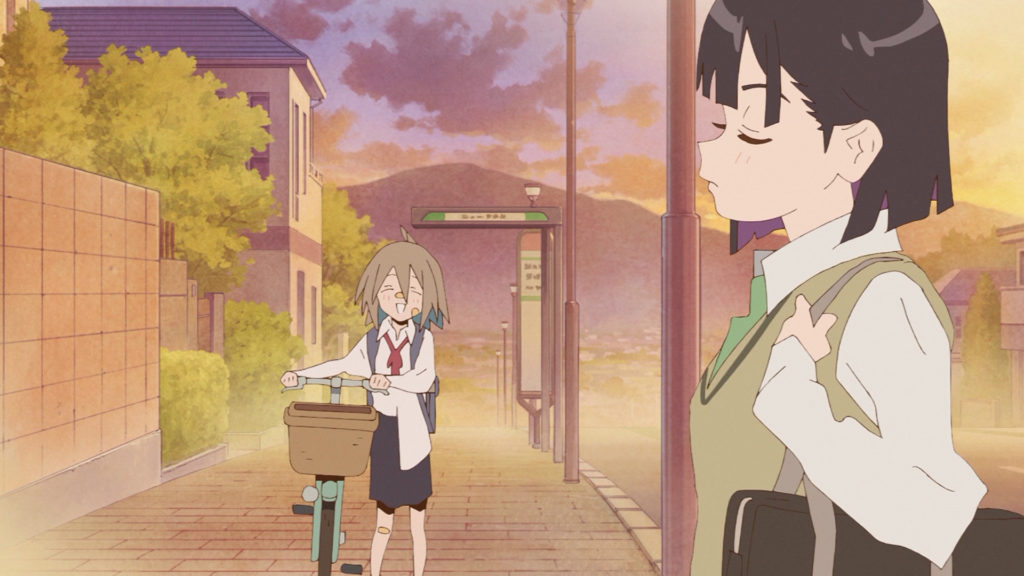 Do It Yourself – Set in a slightly more high tech Japan filled with helpful AI pet robots and quadcopter drones that fill the skies each day as they deliver orders to people’s houses, this show is actually a celebration of putting love and attention in to making things by hand.
Do It Yourself – Set in a slightly more high tech Japan filled with helpful AI pet robots and quadcopter drones that fill the skies each day as they deliver orders to people’s houses, this show is actually a celebration of putting love and attention in to making things by hand.
The show opens with klutzy, high schooler Serufu Yua finding herself at odds with her childhood friend and neighbor Miku Suride. The two are being spit up as they are about to start their first day at different high schools. Serufu is going to a traditional school, while Miku is going to be attending a high tech academy. In an effort to fix their ailing friendship, Serufu ends up joining her school’s Do It Yourself club and starts in on rebuilding a wooden bench that used to sit between their houses.
Along with the injury prone Serufu and her slightly stuck up friend comes a delightful cast of characters all who join the DIY club for different reasons. By the end, they are all participating in making some excellently envisioned arts and crafts to promote their club.
In addition to fun characters and a nice, low-key story, this anime has also gotten a lot of praise for it’s somewhat stylized approach to art and animation. It’s nowhere near flashy as some shows, but apparently a lot of work went into creating and maintaining its complex shot composition and semi-watercolor look.
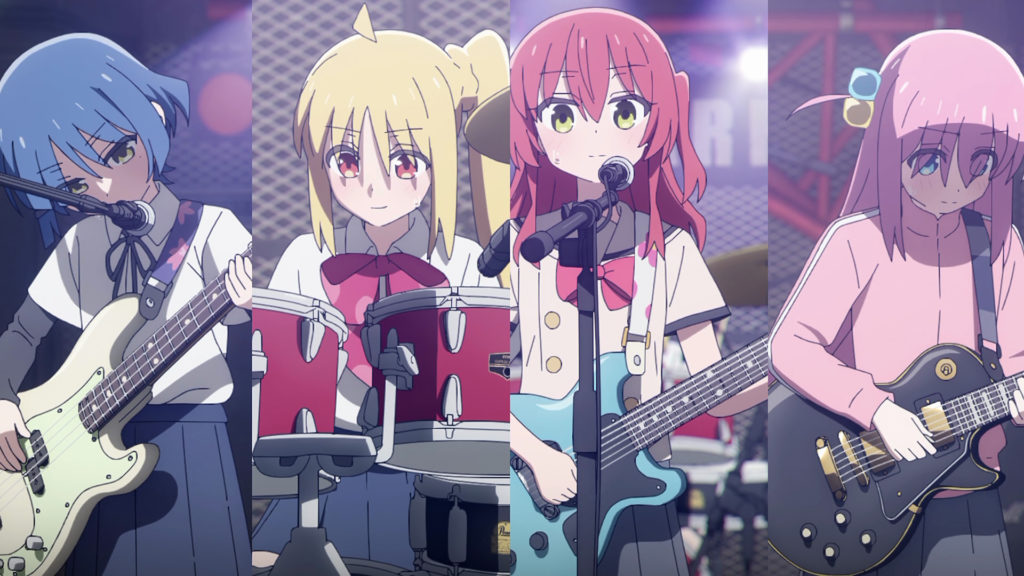 Bocchi the Rock! – At first glance, this show has been done before. Four girls joke and laugh and bond as they throw around tons of witty dialogue whilst forming a band? This show is just K-On! Except, it isn’t. Not at all. Instead, what this fascinating anime provides is a feast of crazy animation and film making techniques that explore the inner thoughts and worries of lead character Hitori “Bocchi” Goto as she is dragged outside her incredibly lonely comfort zone when she is invited to join an after school band.
Bocchi the Rock! – At first glance, this show has been done before. Four girls joke and laugh and bond as they throw around tons of witty dialogue whilst forming a band? This show is just K-On! Except, it isn’t. Not at all. Instead, what this fascinating anime provides is a feast of crazy animation and film making techniques that explore the inner thoughts and worries of lead character Hitori “Bocchi” Goto as she is dragged outside her incredibly lonely comfort zone when she is invited to join an after school band.
Without Bocchi as its lead character, this woud be a show very similar to K-On!. Just one with its characters much more focused on actually forming a band instead of listlessly goofing off and drinking tea. But with Bocchi as its lead, the show is instead this weird, wild, detailed and all too relatable portrayal of how someone with lifelong crippling social anxiety acts and thinks. Bocchi is prone to getting lost in her overwhelming worries and delusional flights of fancy whenever she has to interact with others. The animators put a ton of time and energy into finding ever more inventive ways to portray her inner turmoil with a shockingly wide array of art styles ranging from courtroom sketches and film noir scenes to claymation, puppets, and even brief, jarring moments of live action.
Beyond its inventively artistic portrayals of Bocchi’s often panicked mental state, Bocchi the Rock also boasts a decent knowledge of how bands and clubs operate. And it has a great core cast of primary and secondary characters. And it tuggs at you with great moments of friendship and bonding. And it features a surprising number of fully animated on-stage full length song performances. And it is consistently very strong on the art and animation side of things even outside of Bocchi’s freakout moments.
Yeah, this is a complete, unique package. It’s kinda no surprise it quickly became one of the most talked about animes of the year.
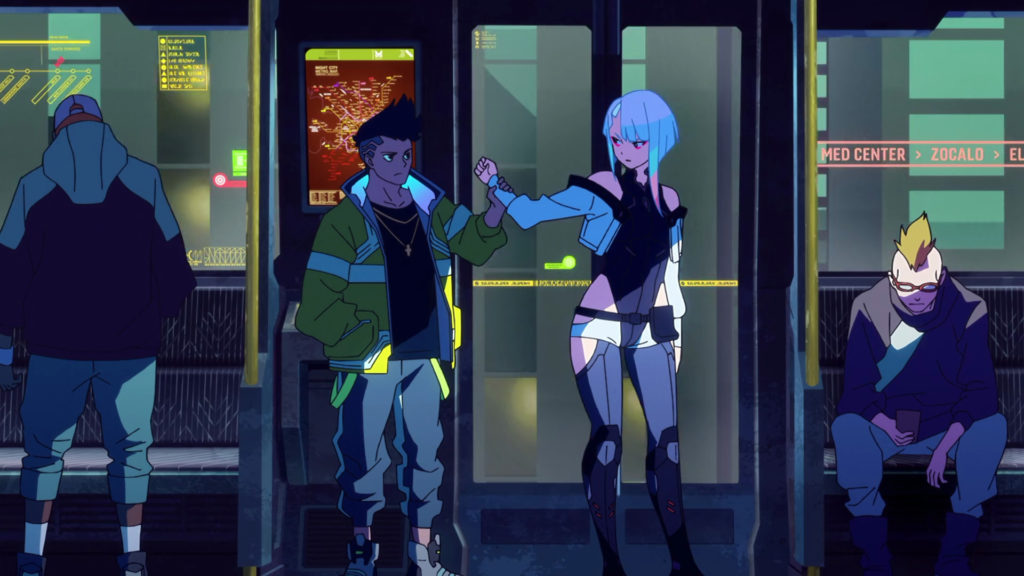 Cyberpunk Edgerunners – There’s an old, ongoing joke that anime studio Trigger’s over the top style, luscious animation, and dedication to each of their projects is just what anime needs… that they saved anime… and it’s not really a joke, because it is also true!
Cyberpunk Edgerunners – There’s an old, ongoing joke that anime studio Trigger’s over the top style, luscious animation, and dedication to each of their projects is just what anime needs… that they saved anime… and it’s not really a joke, because it is also true!
This show was seen as a weird, too long delayed afterthought cash in to the Cyberpunk 2077 video game. The game had suffered an extremely troubled production and had come out with so many bugs, crashes, slowdowns, and flaws that Sony took the drastic step of removing the title from its online store for several months while the worst of the problems were being fixed. The game was almost condemned to failed project status by gamers, so having an anime set in the same world come out more than a year later seemed very odd. But, yeah, Trigger did it again.
As something of a sidestory in the 2077 universe, Edgerunners follows a crazy crew of Cyberpunk mercernaries as they cheat and steal and hack and fight their way to success in a retro futuristic world that offers zero comfort or solace. You either go big or you die trying. Somehow, Trigger took this wild world and filled it with a new stories and new characters that are arguably more compelling that those within the game itself. Add in a stellar soundtrack and shockingly good animation and this show is an absolute winner. The show was so well received, in fact, that it pushed the game back onto the top of the internet’s most played charts for a few weeks more than a year after it had been abandoned by gamers.
So, once again, Trigger saved anime. Oh, and they saved gaming this time, as well!
All The Rest – You might notice this list is missing some of the biggest big name hitters. There’s Spy X Family, Chainsaw Man, and Kaguya-sama: Love Is War‘s 3rd season that I simply haven’t gotten to yet. Attack on Titan is in like part four of its final season and I don’t want to watch it until it is finished. And those are just the ones I can think of…
Yep. 2022 was a great year for anime!
Macross Frontier Episode Guide 28: Labyrinth of Time
 After more than a year since its Japanese release, I was finally able to see the Macross Frontier Short Film: Labyrinth of Time. And I really enjoyed it. This story primarily follows Ranka Lee. In large part because with Alto Saotome lost in space and Sheryl Nome still in a coma, she is the only one of Macross Frontier’s three main characters still active within the camera’s eye. But don’t worry, the story makes it a point to involve the other two.
After more than a year since its Japanese release, I was finally able to see the Macross Frontier Short Film: Labyrinth of Time. And I really enjoyed it. This story primarily follows Ranka Lee. In large part because with Alto Saotome lost in space and Sheryl Nome still in a coma, she is the only one of Macross Frontier’s three main characters still active within the camera’s eye. But don’t worry, the story makes it a point to involve the other two.
We catch up to Ranka on some settled world whose architecture features things that kinda, sorta, look like artistic gold Tokyo Towers. She’s singing at a concert branded as “From Me To You - Ranka Lee”. Ranka is looking confident on stage and we find her sporting a new, slightly more mature haircut that features a neat bit of longer hair hanging off to her left. (Maybe there’s a hip, technical hair term for that… I don’t know what it might be.) She stars off singing Hoshi Kira (Starshine) in front of a huge audience. Both her outfit and the stage in front of her change dramatically thanks to the Macross universe’s ubiquitous hologram technology. Ranka is visually transported back to the Varja homeworld in front of Alto’s downed Valkyrie and is again wearing a white dress with a blue bow similar to the one she wore when she sang for him back then. Midway through the song, though, she receives a sharp pain in her stomach. Her fold bacteria are responding to something. Ranka, who is apparently a much more professional singer these days, continues on with her song, but it looks like she organizes a search for the fold signal immediately after her concert is done.
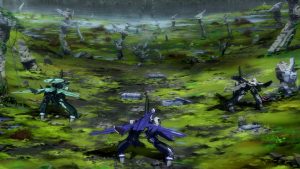 Ranka and her adoptive older brother Ozma, along with Luca, Michael, Klan Klan, and Nanase journey out to a Protoculture ruin set in the middle of a lake on the same planet. There they set up monitoring equipment while Ranka and Nanase set up a shrine of sorts containing items important to Alto and Sheryl. Soon, the ruins begin to respond, and Ranka runs forward as the ruins begin to turn and transform. She enters an energy portal just seconds before it seals itself off and is deposited inside the flooded ruin.
Ranka and her adoptive older brother Ozma, along with Luca, Michael, Klan Klan, and Nanase journey out to a Protoculture ruin set in the middle of a lake on the same planet. There they set up monitoring equipment while Ranka and Nanase set up a shrine of sorts containing items important to Alto and Sheryl. Soon, the ruins begin to respond, and Ranka runs forward as the ruins begin to turn and transform. She enters an energy portal just seconds before it seals itself off and is deposited inside the flooded ruin.
The ruin quickly drains itself as it continues to transform and respond to the song that Ranka begins to sing. Pretty quickly, Ranka and her support staff begin to see images of her memories of Alto and Sheryl made large thanks to the Protoculture technology. As Ranka’s song progresses, we see imagery of her meeting Alto for the first time, and of her calling Alto one night when she was nervous and unable to sleep. Ranka also sees images of herself and Sheryl when they sang together on stage and rode one of Frontier’s Island 1 trolley cars together with Alto and Brera as body guards holding back tons of adoring fans.
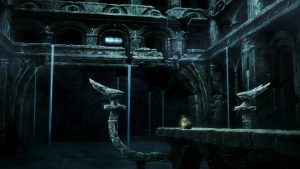 Ranka reaches a central area of the ruins and throws Alto’s paper airplane which begins to soar with the magic of her song… only to drop as Ranka begins to doubt herself. She collapses to her hands and knees and trails off singing “What do you think of me now?” and “Have I become a stronger person?” to the images of Alto and Sheryl. It seems clear that Ranka has grown a lot since the war with the Varja, but she still has that core of self doubt that she displays here.
Ranka reaches a central area of the ruins and throws Alto’s paper airplane which begins to soar with the magic of her song… only to drop as Ranka begins to doubt herself. She collapses to her hands and knees and trails off singing “What do you think of me now?” and “Have I become a stronger person?” to the images of Alto and Sheryl. It seems clear that Ranka has grown a lot since the war with the Varja, but she still has that core of self doubt that she displays here.
Fortunately, Sheryl’s voice echoes through the ruins, singing the first few lines of Diamond Crevasse. Sheryl’s voice lifts Alto’s paper airplane which is soon joined by a flurry of Sheryl’s own butterflies. Encouraged, Ranka begins her song again, questioning if Alto and Sheryl can hear her. Ranka and Sheryl join in a limited duet as the Protoculture ruin comes alive with color and sound. The song and the ruin build in intensity as representations of Sheryl in a wedding dress and Alto in his kabuki gown and flight suit both appear in huge form, so large they are even visible far outside the ruin. Finally, as the song reaches its climax, we see Sheryl reach out to Alto as a beam of energy shoots forth from the ruins and stretches far beyond the planet out past even our galaxy.
When it all ends, Ranka finds herself back in the center of the again dormant ruin, still on her hands and knees. She stands, looks to the sky and says “I’m not losing you this time” as Alto’s paper airplane returns to her hand.
Movie Impressions
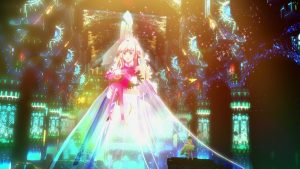 While this short film isn't super densely packed, it does contain a good bit of nostalgia for the two Macross Frontier characters who have been out of the picture since the end of the Wings of Goodbye movie. Ranka looks and sounds better than ever. The whole film is based around her 7+ minute song, and I think it’s one of the character’s best yet. Sheryl always carried the big, weighty musical numbers in the anime and in the movies, but here, Ranka finally gets an epic piece of her own. Something that's not child-like or filled with rainbows and stuffed bears.
While this short film isn't super densely packed, it does contain a good bit of nostalgia for the two Macross Frontier characters who have been out of the picture since the end of the Wings of Goodbye movie. Ranka looks and sounds better than ever. The whole film is based around her 7+ minute song, and I think it’s one of the character’s best yet. Sheryl always carried the big, weighty musical numbers in the anime and in the movies, but here, Ranka finally gets an epic piece of her own. Something that's not child-like or filled with rainbows and stuffed bears.
Beyond the song, the animation and effects were spectacular. I really enjoyed the song when I first heard it several months ago, but I was a little afraid that the animation would consist of nothing more than reused scenes from the anime. Nope! Other than a few brief flashbacks to Wings of Goodbye at the beginning, this was all brand new, highly detailed animation. It looks pretty dang good, too! I was scared we were getting a minor side project, but instead we got something that clearly had a ton of care and attention put into it!
 And then there’s the story. Alto is still far away with the Varja queen. Sheryl is still in her coma. But the two seem to be connected when Ranka awakens the Protoculture ruins. And with that beam, which is said to be an amplified fold wave transmission, I think Sheryl is maybe calling Alto home. With Macross, it’s hard to tell if this is just a one off piece, or something that might be followed up on in a decades time, or the revival of the series’ attention to the Frontier storylines. I would love a new Frontier series. I would also love if we just got a yearly or bi-yearly short film that slowly took us to Alto’s return and Sheryl’s reawakening. But as things are, I just have to brace for this being a one off that will never get a followup. But, even if it is… it still managed to live up to my frankly uncontrolled excitement when I first heard about this new project a couple years ago. So, regardless of what does or doesn’t happen next, I’m glad it exists.
And then there’s the story. Alto is still far away with the Varja queen. Sheryl is still in her coma. But the two seem to be connected when Ranka awakens the Protoculture ruins. And with that beam, which is said to be an amplified fold wave transmission, I think Sheryl is maybe calling Alto home. With Macross, it’s hard to tell if this is just a one off piece, or something that might be followed up on in a decades time, or the revival of the series’ attention to the Frontier storylines. I would love a new Frontier series. I would also love if we just got a yearly or bi-yearly short film that slowly took us to Alto’s return and Sheryl’s reawakening. But as things are, I just have to brace for this being a one off that will never get a followup. But, even if it is… it still managed to live up to my frankly uncontrolled excitement when I first heard about this new project a couple years ago. So, regardless of what does or doesn’t happen next, I’m glad it exists.
Specific Scenes I Loved
Ranka on the big stage. Satelight, the anime studio that handles Macross, is no stranger to singers on stage. They did Macross Frontier and Macross Delta, as well as the highly musical Symphogear series that has its fair share of singers and stages. But, this may be the studio’s most impressive stage yet. The crowd movement with their pen lights is just right. The feeling of vastness works very well. Even the holographic transformation looks spectacular. I really did love these stage scenes.
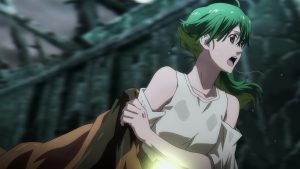 Ranka’s run. During an interlude in her song, Ranka runs and pulls off her soaked jacket as the camera spins round and round her. The background movement plus the near constant redraws of Ranka in the foreground are very impressive. She is in motion removing her jacket and running flat out almost the entire time as the camera continues its fast rotations around her. There’s all sorts of flashy energy portals and giant holograms in this short, but this may be the scene that impressed me the most.
Ranka’s run. During an interlude in her song, Ranka runs and pulls off her soaked jacket as the camera spins round and round her. The background movement plus the near constant redraws of Ranka in the foreground are very impressive. She is in motion removing her jacket and running flat out almost the entire time as the camera continues its fast rotations around her. There’s all sorts of flashy energy portals and giant holograms in this short, but this may be the scene that impressed me the most.
The paper airplane flying once more as Sheryl began to sing. I loved Sheryl reaching out with her song and also loved the fairly subtle reference back to the end of Macross Zero where Mao Nome dropped Shin Kudo’s Valkyrie in the water as her voice briefly wavered. The animation here isn’t really the same at all, but the power of a songstress’ voice being able to lift an airplane? Yeah… that’s totally a Macross thing.
All in All
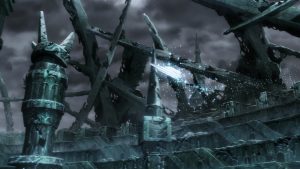 Though this film is short and ends in yet another cliffhanger, I was really glad to dip back into the world of Macross Frontier. It had the music and magic and animation I was looking for in a new installment of the Frontier story. I hope we get more, but even if we don’t, I’ll be grateful for this entry that seems to point the way to a better future for Alto and Sheryl.
Though this film is short and ends in yet another cliffhanger, I was really glad to dip back into the world of Macross Frontier. It had the music and magic and animation I was looking for in a new installment of the Frontier story. I hope we get more, but even if we don’t, I’ll be grateful for this entry that seems to point the way to a better future for Alto and Sheryl.
Review: Akebi's Sailor Uniform Anime
In Short:
Released in 2022 by CloverWorks, Akebi’s Sailor Uniform is a twelve episode anime based on a manga of the same name. It follows twelve year old Komichi Akebi as she starts her first year of junior high at the same all girls private academy that her mother attended several years before. All throughout elementary school Komichi was the only student in her class, so she is beyond thrilled to finally be able to make friends with girls her own age.
Due to an odd mix up, neither Komichi nor her mother realized that the school recently changed its dress code from the bright white sailor-style uniforms Komichi’s mother wore to more modern dress shirts and dark navy blazers. This leaves Komichi as the one girl at her new school who is dressed differently from everyone else. Fortunately, Komichi’s athleticism, endlessly cheerful attitude, and occasional quirkiness help her quickly become the most popular girl in school as she befriends the fifteen other girls in her homeroom class.
Suggested Minimum Watch: 2 Episodes. The first episode largely covers the lead up to getting Komichi to her new school. The second episode, where Komichi first begins to really interact with her classmates, more closely resembles the flow of the rest of the series.
Full Review:
 I was initially a little confused when I heard that the opening song to Akebi’s Sailor Uniform featured the voice actresses of all sixteen members of Komichi’s homeroom class. Having now finished the show, it strikes me as a perfect choice, and one that immediately reflects what the show is all about.
I was initially a little confused when I heard that the opening song to Akebi’s Sailor Uniform featured the voice actresses of all sixteen members of Komichi’s homeroom class. Having now finished the show, it strikes me as a perfect choice, and one that immediately reflects what the show is all about.
The song fits so well because Akebi’s Sailor Uniform strives to give life to every member of Komichi’s class. Each one of these girls is more than just a few facts on a fan wiki. They each have their own lifelike personalities that are slowly revealed during the course of the anime. By the end of the series I had come to know more about each of these sixteen girls and can now tell you at least one noteworthy scene each of them features in.
 For instance, take Toko Usagihara who sits at the desk behind Komichi and is practically the visual and emotional reincarnation of Ritsu Tainaka from K-On! She is someone who is goofy and who loves to mildly tease others, but also someone who enjoys delighting her friends with good-natured surprises. We find that she is actually a bit jealous of Komichi, but she quickly puts that aside to become perhaps the best supporting character in the series.
For instance, take Toko Usagihara who sits at the desk behind Komichi and is practically the visual and emotional reincarnation of Ritsu Tainaka from K-On! She is someone who is goofy and who loves to mildly tease others, but also someone who enjoys delighting her friends with good-natured surprises. We find that she is actually a bit jealous of Komichi, but she quickly puts that aside to become perhaps the best supporting character in the series.
Or, take Riri Minakami, the blond-haired girl that sits on the opposite side of the room from Komichi. She’s an award-winning athlete and someone who is fiercely competitive in most everything she does. She’s also perfectly happy to annoy her fellow classmates if it gets them to interact with her. At one point, she makes a bet with Komichi that leads to one of the most tension filled episodes in this notably low tension series.
 And then there’s Komichi herself. She is this incredible bundle of non-stop energy who tries her absolute best at everything she does. Yes, she’s a little quirky, and a little naive. In some ways, because she lives in a rural area without anyone to interact with other than her mother, father, and adorable little sister, she is just a bit of a country bumpkin. But, to her credit, Komichi is so friendly with and so accepting of her peers that they can’t help but admire her. Her athleticism and generally good grades don’t hurt her any, either. Komichi’s homemade sailor uniform may be the easiest way to pick her out of a crowd at school, but it’s her personality that wins her an entire class of friends.
And then there’s Komichi herself. She is this incredible bundle of non-stop energy who tries her absolute best at everything she does. Yes, she’s a little quirky, and a little naive. In some ways, because she lives in a rural area without anyone to interact with other than her mother, father, and adorable little sister, she is just a bit of a country bumpkin. But, to her credit, Komichi is so friendly with and so accepting of her peers that they can’t help but admire her. Her athleticism and generally good grades don’t hurt her any, either. Komichi’s homemade sailor uniform may be the easiest way to pick her out of a crowd at school, but it’s her personality that wins her an entire class of friends.
One of the things this anime excels at is creating memorable moments of interaction between its characters. Their dialogue. Their actions. Everything just sorta works together to make these characters feel authentic. Frequently, episodes will feature Komichi befriending or hanging out with one or two of her classmates which often leads to unexpected, heartwarming scenes.
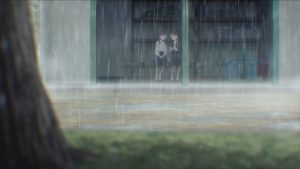 Sometimes, these scenes are defined by their quietness. At one point, Komichi and a friend are trapped at a bus stop by a sudden downpour and choose to read a book together until the rain lets up. Other times, these scenes can be quite energetic. Like when one of Komichi’s friends attempts to teach her how to cook with somewhat disastrous results.
Sometimes, these scenes are defined by their quietness. At one point, Komichi and a friend are trapped at a bus stop by a sudden downpour and choose to read a book together until the rain lets up. Other times, these scenes can be quite energetic. Like when one of Komichi’s friends attempts to teach her how to cook with somewhat disastrous results.
What’s remarkable is how natural each of these moments feel. Although Akebi’s Sailor Uniform has a bit of tension here and there, and a fair amount of humor sprinkled throughout, the show doesn’t really exist to push melodrama or jokes with punchlines. This isn’t really a K-On!, a A Place Further Than The Universe, or a Sound! Euphonium. It’s more like the show is just here to give us a peak into the girls’ lives. Even their occasional goofy or embarrassing moments are used to reveal these girls’ inner thoughts or dig up some small nuggets of backstory. Many of these moments often have subtle but lasting impacts, too. Like how being temporarily trapped at the bus stop leads Komichi to finally figure out which school club she wanted to join. And how, by joining that club, she inadvertently ends up helping another one of her classmates find the confidence to learn a new skill later on.
 Sure, sometimes the girls in Akebi’s Sailor Uniform do notably silly or odd things. The show makes it a minor point to not shy away from embarrassing moments which led to some on The Internet to mistake it for being far more weird or far less wholesome than it actually is. I’ll talk more specifics down in the Dig Deeper section below, but basically, if you see someone accusing the show of being anything but pure and good-natured, there’s a good chance they’re vastly overblowing one scene or another.
Sure, sometimes the girls in Akebi’s Sailor Uniform do notably silly or odd things. The show makes it a minor point to not shy away from embarrassing moments which led to some on The Internet to mistake it for being far more weird or far less wholesome than it actually is. I’ll talk more specifics down in the Dig Deeper section below, but basically, if you see someone accusing the show of being anything but pure and good-natured, there’s a good chance they’re vastly overblowing one scene or another.
Art and Animation:
Akebi’s Sailor Uniform owes a lot to its manga. Perhaps more than most anime. It, of course, gets its strong characters and heartwarming plots from its print version, but it also gets a lot of its art and even its animation almost directly from its manga!
 Some of the most detailed scenes of animation in the anime, like Komichi tying her hair back into a ponytail, or the fun episode four ending credits where Komichi does some impressive jump rope tricks, come from moments where the manga would drop everything away and just string together three, or four, or a dozen impressive close ups of Komichi in motion. The anime does a terrific job of taking the detailed art style of the manga and giving it a place where its static drawings could come to life with real motion.
Some of the most detailed scenes of animation in the anime, like Komichi tying her hair back into a ponytail, or the fun episode four ending credits where Komichi does some impressive jump rope tricks, come from moments where the manga would drop everything away and just string together three, or four, or a dozen impressive close ups of Komichi in motion. The anime does a terrific job of taking the detailed art style of the manga and giving it a place where its static drawings could come to life with real motion.
There are certainly anime out there that feature more animation. More frames. More effects. And more details than this show. But I see Akebi’s Sailor Uniform as an animator’s anime. This is a show that Tsubame Mizusaki, a character from the anime Keep Your Hands Off Eizouken, would want to work on. She was representative of any number of hard working animators determined to go the extra mile to depict movement and emotion despite all too common time crunches and budget pressures. And that’s just what Akebi’s Sailor Uniform does. It features a fair amount of stunning backgrounds and takes a ton of delight in conveying emotive movements without the benefits of the seemingly unlimited budgets that some anime shows or movies seem to be gifted with.
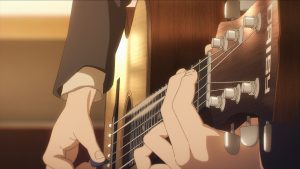 Sometimes the show has to drop to beautiful still panning shots to get its point across, but when it really wants to animate something, it does so brilliantly. This is a show that, in brief moments of effort, can rival Sound! Euphonium in its depictions of a musical instrument or challenge volleyball anime Haikyuu!! for the best depiction of a game winning spike.
Sometimes the show has to drop to beautiful still panning shots to get its point across, but when it really wants to animate something, it does so brilliantly. This is a show that, in brief moments of effort, can rival Sound! Euphonium in its depictions of a musical instrument or challenge volleyball anime Haikyuu!! for the best depiction of a game winning spike.
As I already mentioned, Akebi’s Sailor Uniform does something fun and unique with its opening song by allowing all sixteen of the main voice actresses to participate. The ending theme is nice and warm in a way that fits the show well. There’s also a nice song or two within the anime sung or played by characters. Interestingly enough, the production also recorded a short album by Komichi’s favorite idol, Miki Fukumoto. You can hear those tracks in a couple places throughout the anime.
All In All:
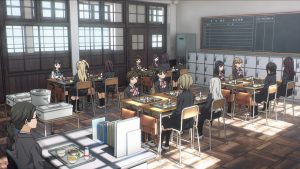 Akebi’s Sailor Uniform is a fun, good-natured show that allows its energetic lead to become the glue that binds her entire junior high class together. It’s got some great music, some great animation, and does a particularly good job of creating impactful moments while it spreads its story around its fairly large cast of characters. And it does all this without resorting to any sort of tragedy or drama. It was a true delight to watch, and I think it will be well regarded as one of the better pure slice of life anime yet produced.
Akebi’s Sailor Uniform is a fun, good-natured show that allows its energetic lead to become the glue that binds her entire junior high class together. It’s got some great music, some great animation, and does a particularly good job of creating impactful moments while it spreads its story around its fairly large cast of characters. And it does all this without resorting to any sort of tragedy or drama. It was a true delight to watch, and I think it will be well regarded as one of the better pure slice of life anime yet produced.
 With a title like Akebi’s Sailor Uniform, you naturally wonder “why does this girl care so much about her school clothes?!” I loved the way it set up and layered Komichi’s reasons for loving her uniform. Komichi first fell in love with sailor uniforms the way kids get enamored by lots of this: by seeing it on tv. Specifically, Komichi saw her favorite teen idol, Miki Fukumoto, star in a random commercial for a brand of bottled water and Komichi couldn’t help but fall in love with Miki’s sailor uniform.
With a title like Akebi’s Sailor Uniform, you naturally wonder “why does this girl care so much about her school clothes?!” I loved the way it set up and layered Komichi’s reasons for loving her uniform. Komichi first fell in love with sailor uniforms the way kids get enamored by lots of this: by seeing it on tv. Specifically, Komichi saw her favorite teen idol, Miki Fukumoto, star in a random commercial for a brand of bottled water and Komichi couldn’t help but fall in love with Miki’s sailor uniform.
But then the show goes further, and has Komichi find a picture of her mom wearing a similar uniform back when she was Komichi’s age. Really though, knowning Komichi’s mom, I bet she dug that picture out for her daughter. Komichi’s mom was so active and supportive, I can just imagine her getting a lot of enjoyment seeing her daughter freak out over that old photo.
 Then there’s the way they go together to the fabric store and Komichi’s mom lets her pick out the colors. And the way that Komichi takes up every household chore so as to allow her mom more time to work on her uniform. And it all comes together in that highly detailed almost dreamy shot of Komichi posing for her mother and sister downstairs after pulling on her new school clothes with that small, pure smile on her face. Simply amazing.
Then there’s the way they go together to the fabric store and Komichi’s mom lets her pick out the colors. And the way that Komichi takes up every household chore so as to allow her mom more time to work on her uniform. And it all comes together in that highly detailed almost dreamy shot of Komichi posing for her mother and sister downstairs after pulling on her new school clothes with that small, pure smile on her face. Simply amazing.
To me, the whole first half of the first episode did a terrific job of selling why Komichi’s sailor uniform was so important to her. It also really kinda gets all of that out of the way so the show can focus on character moments later on with the uniform just being a common thread (yes… pun away…) linking Komichi to her friends.
 Oh. And I didn’t mention her too much in the main review, but Komichi’s little sister Kao is this show’s secret weapon. My favorite moment with her has to be the time she greeted volleyball star Hitomi Wasio with “You’re big!” only to get picked way up in the air by Hitomi, who is the tallest girl in Komichi’s class. “What is this little thing?” Hitomi deadpans while Kao giggles and cheers. 🙂
Oh. And I didn’t mention her too much in the main review, but Komichi’s little sister Kao is this show’s secret weapon. My favorite moment with her has to be the time she greeted volleyball star Hitomi Wasio with “You’re big!” only to get picked way up in the air by Hitomi, who is the tallest girl in Komichi’s class. “What is this little thing?” Hitomi deadpans while Kao giggles and cheers. 🙂
Another thing I liked a lot about the show was the way it occasionally added these extra layers of depth to its characters. Sometimes in unexpected ways. Two big examples here:
– The way Toko Usagihara’s smile briefly fades after she lends Komichi her blue dress. Toko says something like “If I were you I might have gone to school in Tokyo…” Later, after Komichi enthusiastically fails at cooking, Toko says: “I feel kinda relieved, though. I thought you were this perfect girl that could do anything.” In a show that is almost entirely devoid of conflict… Toko’s tinge of jealousy at Komichi’s looks and skills is really neat to catch on to.
 – The anime does a really good job of adapting Erika’s storyline. Specifically in relation to her willingness to play the piano. At the beginning of the school year, Erika had not played her piano for some time. She had one in her dorm room, but it was covered in dust. Later, she wipes off that dust, and later still, we get to see her play a few notes on the piano in the music room while Komichi and Oshizu Hebimori hide from her. As the series draws to an end, Erika shakes off her rust while practicing for Komichi’s big afterparty dance. When Erika gets up on stage and plays her heart out for Komichi she oddly thinks: “The only reason I was able to enjoy playing like this again… was because of Komichi-san.”
– The anime does a really good job of adapting Erika’s storyline. Specifically in relation to her willingness to play the piano. At the beginning of the school year, Erika had not played her piano for some time. She had one in her dorm room, but it was covered in dust. Later, she wipes off that dust, and later still, we get to see her play a few notes on the piano in the music room while Komichi and Oshizu Hebimori hide from her. As the series draws to an end, Erika shakes off her rust while practicing for Komichi’s big afterparty dance. When Erika gets up on stage and plays her heart out for Komichi she oddly thinks: “The only reason I was able to enjoy playing like this again… was because of Komichi-san.”
There’s a second half to Erika’s story. Later in the manga we get to see the capital ‘R’ Reasons of why Erika stopped playing her piano earlier in life. There’s a bunch of little details dropped in the anime about this. Even one of the school clubs Erika joins is relevant, but the key piece of the puzzle is left out on purpose. As the story progresses past the ending of the anime, you begin to realize that there’s even more to Erika’s character than you thought there was. I love that the anime did the ground work for that future story even though it probably knew it’d never get to tell the second half.
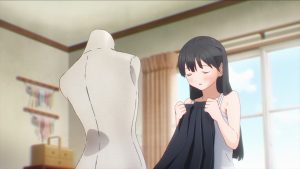 Finally… the thing that disappointed me the most about Akebi’s Sailor Uniform was the way a few on The Internet reacted to it. There were some who strongly implied or outright accused it of being lewd. Of objectifying and sexualizing young girls. For the most part, I think these accusations are complete nonsense. That they say far more about the commentator than they do the show. Maybe that’s a bit of a mean way of putting it, but I read way too many people comment that they were hesitant about watching this show because of what others said about it. Which is a shame when the show is almost entirely pure and good-natured.
Finally… the thing that disappointed me the most about Akebi’s Sailor Uniform was the way a few on The Internet reacted to it. There were some who strongly implied or outright accused it of being lewd. Of objectifying and sexualizing young girls. For the most part, I think these accusations are complete nonsense. That they say far more about the commentator than they do the show. Maybe that’s a bit of a mean way of putting it, but I read way too many people comment that they were hesitant about watching this show because of what others said about it. Which is a shame when the show is almost entirely pure and good-natured.
There were people who got worked up over Erika sniffing her nail clippers. To me, this was a scene that basically served to break the ice between Erika and Komichi, and was something Erika would not normally do. She straight up said she did not normally take her nail clippers with her. I think this was an embarrassing moment that the anime decided not to shy away from. And why should it have? Yes, it was embarrassing… but it was also something done on a whim. The point here was that Erika was nervous about her first day of school, and that Komichi’s act first, think later nature help start them down a path towards friendship.
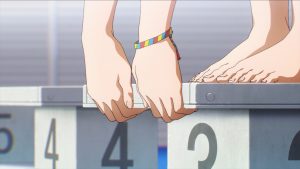 There were plenty of others who accused the show of having a foot fetish. To me, this is just complete nonsense. Yes, we got quite a few detailed frames of feet in this show. But not a single one of them was lewd in any way. Komichi fidgeting while she talked with her father on the phone, or the show detailing a close up of her feet while she stood poised to jump into the pool… is not anything! Of all the accusations, the ones saying the show has a “foot fetish” are the ones that made me the most angry because the accusation is entirely made up.
There were plenty of others who accused the show of having a foot fetish. To me, this is just complete nonsense. Yes, we got quite a few detailed frames of feet in this show. But not a single one of them was lewd in any way. Komichi fidgeting while she talked with her father on the phone, or the show detailing a close up of her feet while she stood poised to jump into the pool… is not anything! Of all the accusations, the ones saying the show has a “foot fetish” are the ones that made me the most angry because the accusation is entirely made up.
The other moment I think people got worked up over unnecessarily over was the scene where Komichi pulls on her skirt and sailor uniform for the first time. The anime showed it in a lot of detail. So did the manga. But not because it was objectifying her. It did so because this was a special moment in this girl’s life. Her mother had made these clothes for her. She was trying them on for the first time. This outfit is one she knew would largely define her to her classmates at her new school for the next few years. And it’s not like Komichi was dressed provocatively in any way prior to pulling on her clothes. Her undergarments were actually surprisingly modest. Again, I think people who tried to turn this moment of awe in this girl’s life into something crude deserve some serious push back.
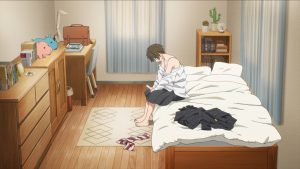 There was one scene in the show I do think deserves some scrutiny. In episode 3, Kei Tanigawa arrives home to find that her mom has gone out shopping. Alone in her room, she takes some partially undressed selfies. Komichi had spent the day pestering her to show off her legs. Telling her how pretty she thought her skin was. That part, I see as innocent. Komichi is the same girl who will smell her own feet or try to trade her sailor uniform top for a classmate’s blazer in the middle of class without thinking things through.
There was one scene in the show I do think deserves some scrutiny. In episode 3, Kei Tanigawa arrives home to find that her mom has gone out shopping. Alone in her room, she takes some partially undressed selfies. Komichi had spent the day pestering her to show off her legs. Telling her how pretty she thought her skin was. That part, I see as innocent. Komichi is the same girl who will smell her own feet or try to trade her sailor uniform top for a classmate’s blazer in the middle of class without thinking things through.
What Kei did, though… we only have to listen to her own inner thoughts as she snapped the photos on her phone.
“I actually took one! That’s so risque!”
“But it’s not lewd or anything… right?”
“I’m just taking a picture of myself.”
“And yet my heart is pounding.”
“I might be… a pervert.”
“I can’t send any of these.”
Yeah, this is a girl who knows what she is doing… has decided that what she is doing… is wrong. Or at least that she is uncomfortable with it. So… why does the anime show it? I think it has to do with one of her final thoughts:
“It’s like I’m seeing a version of myself I don’t know.”
Kei is seen by her classmates as the proper, strict, rules following student who cozies up to the teachers. And that annoys her a good bit.
“I can hear you.” She thinks to herself about the criticism others voice about her when she isn’t in the room. “I’m not trying to be particularly serious or anything. I just… don’t think anything is worth getting in trouble with the teachers over.”
These are the thoughts and the actions of a girl who is a little depressed by how others see her. By following the rules at school, she is not doing anything wrong at all. And yet, socially… she is. Kei looks over to Komichi, a girl who dances freely in the courtyard or who abruptly approaches people to ask them how they are doing, and wishes she herself could be a little less uptight.
“She so easily does the things I’ve always wanted to, but couldn’t.” Kei thinks about Komichi.
And that’s what she does with her selfies. They are minor acts of rule breaking. A minor rebellion. If the girl herself sees her own actions as a little risque or lewd, we can’t really argue with that, can we?
It’s our jobs as viewers to weight the anime’s willingness to show us these actions and scenes with the value they bring to the story or character. To me, there’s real value here. Of seeing the shy, depressed Kei alleviating some of her negative feelings.
We should also consider what Kei did afterwards and how this changed her. Did she fall into the clutches of a predator? Did she make this an ongoing habit? No. Aside from one accidentally sent photo, this is the only time we know of her doing this. And, on the positive side, her actions seem to have unlocked her love of photography. She went on to join the photography club. She pretty much became the class photographer and even made a wholesome photobook about her friends. If the show had shown us a fully nude shot of this girl then the equation would certainly change.
On balance, I think this was a positive thing the show did. It peered into a girl’s insecurities and we saw her address and overcome them. She is much happier at the end of the series than she is at the beginning and with no apparent ill effects otherwise. What sort of judgement should we put on the writers or animators for this sort of outcome?
Would the story be better without a couple of those lewd shots appearing on screen? Are we to just outright ban girls and women from ever doing anything we consider bad? Some of these questions you can only answer for yourself. But, you also need to properly convey context to others if you’re going to bring up these issues with them.
My answers? I think this was a good character moment. Yes, one that pushed some boundaries in some minor ways, but, on the whole of things, was nowhere close to what some people were presenting it as. I think it fit in with this show that is willing to mix in a few embarrassing moments with the far larger number of sweet, wholesome ones to tell a story of realistic characters and their actions.
Review: Gekijouban Shoujo☆Kageki Revue Starlight Movie
I finally got to see the Revue Starlight Movie, and it was incredible.
 The anime series, which the movie follows up on, was mostly about main character Karen Aijo refocusing on her acting ability in order to star in a lead role of the musical stage play Starlight alongside her childhood friend Hikari. Their determination to fulfill their promise to be stars together helped show the other stage actresses at their musical theater academy what it really meant to be Stage Girls. The show beautifully explored the motivations of each of the nine main cast members by pitting them against each other in one on one magical musical stage battle Revues where they fought with swords and axes and bows, but where their drive and stage presence determined who won the day. Ultimately, Karen and Hikari’s promise brought together their entire class as friends who now realized that being the one exclusive Top Star wasn’t all there was to musical theater. It drove home the message that even when you fail you can always stand up and try again.
The anime series, which the movie follows up on, was mostly about main character Karen Aijo refocusing on her acting ability in order to star in a lead role of the musical stage play Starlight alongside her childhood friend Hikari. Their determination to fulfill their promise to be stars together helped show the other stage actresses at their musical theater academy what it really meant to be Stage Girls. The show beautifully explored the motivations of each of the nine main cast members by pitting them against each other in one on one magical musical stage battle Revues where they fought with swords and axes and bows, but where their drive and stage presence determined who won the day. Ultimately, Karen and Hikari’s promise brought together their entire class as friends who now realized that being the one exclusive Top Star wasn’t all there was to musical theater. It drove home the message that even when you fail you can always stand up and try again.
The movie simply asks: Then what?
 For Karen, the driving force in her life ever since she was a child has been her powerful but naive promise to star beside her friend in one particular play. She did that. So, what happens to her determination and drive once she achieves her goal? For the others, the movie takes a deeper look into places the show left them at in relation to their friends. All of them are graduating soon. Where will they go? What stage will they seek out? How will being pulled apart after graduation affect their relationships with each other?
For Karen, the driving force in her life ever since she was a child has been her powerful but naive promise to star beside her friend in one particular play. She did that. So, what happens to her determination and drive once she achieves her goal? For the others, the movie takes a deeper look into places the show left them at in relation to their friends. All of them are graduating soon. Where will they go? What stage will they seek out? How will being pulled apart after graduation affect their relationships with each other?
Like the series, the movie is more a spectacle than a story. The heart of the movie, as was true of the heart of the show, are its incredibly artistic and deeply layered Revues. In them, stage combat set to awesome musical duets filled with vivid, imaginative imagery see the girls’ desires and motivations clash against each other in order to reveal their true feelings.
 Should they continue to take their acting seriously after they graduate? How do you support one another if you both want to be stars rather than merely a leader and a follower? Can fear, rivalry, and jealously be channeled for a greater good? What happens if one person wants to take a different path than the other wishes for them? How can a honest, heated rivalry help drive people to greater heights? It’s these kinds of things that are explored in the midst of battles set in a variety of locations like the top of speeding subway trains, within olympic sports competitions, or as part of over the top stage dramas set inside other stage dramas.
Should they continue to take their acting seriously after they graduate? How do you support one another if you both want to be stars rather than merely a leader and a follower? Can fear, rivalry, and jealously be channeled for a greater good? What happens if one person wants to take a different path than the other wishes for them? How can a honest, heated rivalry help drive people to greater heights? It’s these kinds of things that are explored in the midst of battles set in a variety of locations like the top of speeding subway trains, within olympic sports competitions, or as part of over the top stage dramas set inside other stage dramas.
Art and Sound
The Revue Starlight Movie is animated beautifully with many different settings featuring tons of bold, bright colors and well thought out designs. This is easily the prettiest Revue Starlight has ever been. With the movie-level budget and lack of week to week tv show deadlines, the team was able to really stretch their legs as compared to the tv series while still matching it stylistically. In some ways, the Revue Starlight art style is a bit simpler than the “animated realism” you see from movies like Belle or Your Name. Backgrounds are a bit more painterly and a bit less complex, for instance. But that doesn’t mean the movie skimps on lighting or location design or animation. Revue Starlight has always been very aware that it’s job is to portray the grandeur of the stage, and the movie does just that on numerous occasions.
The magical Revue battles, which were always the artistic high points of the series, are even more so in the movie. There’s just a bit of extra lavishness to all of them. If the big episode eight fight between Hikari and Banana with its dramatic tension and incredible scene changes was the high bar for the series, it would be something closer to the minimum level of extravagance for most of the Revues in the movie. There are stunning scene changes, killer outfits, great use of wide shots and of close ups, and just a general heaping of theatrics infused within every scene.
The music in the movie is just as wonderful. There are definitely a bunch of callbacks. One of my favorites is a new slow instrumental version of “Knowledge of a Stage Girl” that does a wonderful job of enhancing a tender moment at the party kicking off the girls’ final theater festival. There’s also a bunch of great new music. All the new Revues, of course, have their own full length scores, and they are awesome. The visuals of the Revues are all outstanding, but the music isn’t left behind at all. Some of the most powerful moments come precisely because the way the music and visuals come together.
Throughout it all, this movie is still very much Revue Starlight… meaning it just oozes stunning theatrics from beginning to end, all heavily smothered in layers of intriguing metaphor. Like, why does a tomato explode in the middle of an endless desert just seven seconds into the film? Or, why, at one point, do we see the girls in their normal street clothes standing over themselves in their more ostentatious Revue outfits lying dead soaked in blood, which may or may not be tomato juice. What does it mean for a subway car to transform into a moving battleground? What does it mean to have one person who was engaged in an on-stage duel with a rival to suddenly vanish then reappear while clapping for their opponent from the seats of the audience? It’s kinda amazing how much of the movie’s visual grandeur exists to both be pleasing to the eye but to also prompt further thought. This is a movie that can be analyzed for days and days and still have more to show you.
All In All
 The Revue Starlight Movie, like the show, is different from most any other anime out there. It is theatrics and hand to hand combat and catchy duets and constantly shifting imagery and fourth wall breaks that all serve to peel back the layers of its characters’ motivations. I think it is brilliant, but you have to be willing to both revel in its overwhelming spectacle but also be willing to put all that aside and look beyond the flash to see the interesting character moments waiting beneath. If you’re able to do so, you’ll find a series and a follow up movie that will blow you away with how well they are put together and how much fun they are.
The Revue Starlight Movie, like the show, is different from most any other anime out there. It is theatrics and hand to hand combat and catchy duets and constantly shifting imagery and fourth wall breaks that all serve to peel back the layers of its characters’ motivations. I think it is brilliant, but you have to be willing to both revel in its overwhelming spectacle but also be willing to put all that aside and look beyond the flash to see the interesting character moments waiting beneath. If you’re able to do so, you’ll find a series and a follow up movie that will blow you away with how well they are put together and how much fun they are.
 One word of warning, you absolutely have to have seen the show before you start the movie. The Revue Starlight Movie just assumes you know what happened before and goes straight to what happens next. On the bright side, this means it doesn’t bog down at the beginning reminding you of what you already know, but it also means that you won’t really understand the characters or their actions very well at all if you haven’t seen the show.
One word of warning, you absolutely have to have seen the show before you start the movie. The Revue Starlight Movie just assumes you know what happened before and goes straight to what happens next. On the bright side, this means it doesn’t bog down at the beginning reminding you of what you already know, but it also means that you won’t really understand the characters or their actions very well at all if you haven’t seen the show.
There’s a ton more to talk about, so, if you’ve seen the movie, expand the section below and come Dig Deeper with me!
Each of the movie’s six Revues are awesome, eclectic weldings of singing, dancing, acting, stage combat, music, and orchestration. Like in the series, they all take place in a fictional, magical space, though this time the movie integrates this “Stage of Fate” a bit more directly into the real world whereas the series basically saw it solely located underneath the girls’ musical theater academy. Every one of these Revues is highly metaphorical and highly layered with details big and small.
I promise I did not notice all the nuance and subtle references. Some of the stuff is simply impossible to catch unless you are a native Japanese speaker, and I’m not one. But, I tried my best to share some insights and interpretations of each Revue. Please let me know if you noticed something I didn’t or if you you have a different opinion.
Revue of Annihilation
 Banana fought and struggled for so long to keep herself and her classmates trapped in a time loop where everyone lived out the same happy year over and over. In the series, that loop was eventually broken and time began moving forward again. If there’s anybody that knows that you have to focus on what comes next, it’s Diba Nana. This whole Revue is her taking out her frustration on her friends who have kinda become more interested in bickering among themselves than focusing on where it is they will each go next. It’s Banana telling them that no matter where they go they need to be prepared for a new fight because just accomplishing a successful theater production in the past doesn’t mean landing a new role on a new stage will be automatic or a given in the future.
Banana fought and struggled for so long to keep herself and her classmates trapped in a time loop where everyone lived out the same happy year over and over. In the series, that loop was eventually broken and time began moving forward again. If there’s anybody that knows that you have to focus on what comes next, it’s Diba Nana. This whole Revue is her taking out her frustration on her friends who have kinda become more interested in bickering among themselves than focusing on where it is they will each go next. It’s Banana telling them that no matter where they go they need to be prepared for a new fight because just accomplishing a successful theater production in the past doesn’t mean landing a new role on a new stage will be automatic or a given in the future.
Banana is one of the most gifted actresses among our nine main Stage Girls and she finally gets a chance to show that off brilliantly. She takes on everyone at once and takes them apart with ease. Pay attention to her lyrics. In the second half of the battle, the words she is singing are direct criticisms of the faults of the other girls as she defeats them in battle. Only Maya, who already understands the coming battles of her next stage, is able to stand up to Banana. It’s fitting then that she is the only one that Banana does not criticize.
 The music here is interesting because it is somehow both frantic but monotone at the same time. I think it’s the perfect representation of Banana. Incredibly talented, but bursting with an over the top intensity that sorta flattens everything out. Both she and the music are a bit too intense to have a proper, normal range.
The music here is interesting because it is somehow both frantic but monotone at the same time. I think it’s the perfect representation of Banana. Incredibly talented, but bursting with an over the top intensity that sorta flattens everything out. Both she and the music are a bit too intense to have a proper, normal range.
Ultimately, Banana is trying to be helpful. Trying to show them that they must chart their own courses or die as Stage Girls. She is even trying to be encouraging to Karen who she almost straight up asks “what will you do next?”. While off the stage, Diba Nana is everyone’s gentle, hard working, lovable “Banana” who cooks them meals and gives them back rubs. But, while on the stage, she is harsh and fearsome, and wholly devoted to her craft. That second one is the Banana we are seeing in this Revue.
Junna’s comment at the end after Banana cuts off her cloak so dismissively relates to how usually Banana is lovable and supportive. It’s rare to see her in full on full intensity acting mode.
Revue of Malice
 In some ways this is still the hardest Revue to wrap my head around. Why are Futaba and Kaoruko fighting again if they made up and were “fine” by the end of their Revue in the series? The answer is they weren’t fine! They just put that fact aside for a while longer.
In some ways this is still the hardest Revue to wrap my head around. Why are Futaba and Kaoruko fighting again if they made up and were “fine” by the end of their Revue in the series? The answer is they weren’t fine! They just put that fact aside for a while longer.
In reality, Kaoruko had been using Futaba for most of their lives. Relying on her. Taking her for granted. Taking advantage of her in so many ways. From having Futaba buy her food and candy, to using her as free transportation, to having her wake her up in the morning and more. Kaoruko took so much and offered so little in return.
And that might have been fine, if Kaoruko had simply cheered Futaba on as her friend devoted herself to becoming a better Stage Girl. Instead, Kaoruko got jealous. And though she got better about fending for herself at the end of their episode, she apparently never really did help or encourage her lifelong friend.
This Revue is a breakup, but it’s also very interesting thematically! In a couple of ways:
1. The beginning with Kaoruko and Claudine is a homage to Samurai movies where the challenger comes to call out their rival in order to duel them and ultimately kill them. I love how both Kaoruko and Claudine play their proper parts thanks to the magic of the Revues.
2. Think about the roles Kaoruko and Futaba play once we reach the cabaret portion of the Revue. In the real world Takarazuka Revue system, which Revue Starlight is heavily based on, the Top Star is always an Otokoyaku. A girl playing a male role. But here we have Kaoruko, someone who earlier in the film was fretting over whether the Auditions had started again because someone else might become Top Star, now playing a Musumeyaku role! A female role. Sure, she is glamorous and sexy and angry, but it is Futaba playing the more prestigious role! That’s important.
 Although this Revue started with Kaoruko and Claudine, I think it is really Futaba’s Revue. “It’s not fair!” She keeps saying. “Why won’t you understand?!” And finally “We can’t go together anymore!” Futaba has decided her own advancement as a Stage Girl is more important than the unfair relationship she has had with Kaoruko all her life. And I say good for her!
Although this Revue started with Kaoruko and Claudine, I think it is really Futaba’s Revue. “It’s not fair!” She keeps saying. “Why won’t you understand?!” And finally “We can’t go together anymore!” Futaba has decided her own advancement as a Stage Girl is more important than the unfair relationship she has had with Kaoruko all her life. And I say good for her!
But there is one thing at the end that shows the love Futaba still has for Kaoruko. She lends Kaoruko her bike. The bike is more than simply a bike. It’s a symbol of all the years Futaba spent supporting Kaoruko. I think it’s Futaba’s way of saying “I can’t be with you right now, but I won’t just abandon you. I’ll still support you the ways I can.” That’s pretty awesome. In the series, Kaoruko learned to assert herself and stop relying on Futaba so much. Hopefully she can learn to appreciate Futaba properly at some point in the future… But for now, I think this may be the most bittersweet of all the Revues as there is little sign that things might one day end well.
Revue of Competition
 “Mahiru has gone nutty again,” someone on Twitter said. But that’s not the case. In this Revue, Mahiru both puts on the performance of her life and does the right thing by convincing Hikari to apologize to Karen for leaving after performing Starlight with her. Mahiru is shown competing in lots of Olympic sports, but her real role here is that of the caring big sister, once more, just like she used to be to her siblings back home.
“Mahiru has gone nutty again,” someone on Twitter said. But that’s not the case. In this Revue, Mahiru both puts on the performance of her life and does the right thing by convincing Hikari to apologize to Karen for leaving after performing Starlight with her. Mahiru is shown competing in lots of Olympic sports, but her real role here is that of the caring big sister, once more, just like she used to be to her siblings back home.
I love the sports angle of the Revue. Especially the way that Hikari and Mahiru keep switching from their Revue costumes to competing in the various sports. The back and forth instant transitions are really cool. The quick sequence that goes from Hikari throwing her dagger to tennis to volleyball to baseball is just incredible! I also wonder a bit if this Olympics Revue was included because Tokyo was hosting the Olympics the year this movie came out in Japan.
 Mahiru does get scary for a bit during this Revue, and its great how the music shifts from her fun, goofy sports theme to something much more frightening, but it’s all an act to scare Hikari into doing the right thing. Into apologizing to Karen both for leaving recently, and maybe for the way she ran away from Karen as a child and never made an effort to be her friend all those years they were apart. Mahiru knows she is not the best Stage Girl. That others will outperform her in singing and dancing and acting. But a hallmark of her character is the desire to help support others and make them smile.
Mahiru does get scary for a bit during this Revue, and its great how the music shifts from her fun, goofy sports theme to something much more frightening, but it’s all an act to scare Hikari into doing the right thing. Into apologizing to Karen both for leaving recently, and maybe for the way she ran away from Karen as a child and never made an effort to be her friend all those years they were apart. Mahiru knows she is not the best Stage Girl. That others will outperform her in singing and dancing and acting. But a hallmark of her character is the desire to help support others and make them smile.
I think Mahiru mainly did this for Karen, to help her when she is confused about where to go next. But, I think Mahiru also did it a little for Hikari and also for herself. She helped spur Hikari on, but she also proved to herself that she can act. Of all the Revues, this is the sweetest because Mahiru is a genuinely sweet person. Need even more proof? At the beginning of the scary part of her performance, Mahiru knocked the head off of Hikari’s Mr. White mascot. But at the end, one of the two figures holding the red finish line for Hikari is her Mr. White with its head taped back on. Mahiru fixed it just for Hikari! 🙂
Revue of Hunting
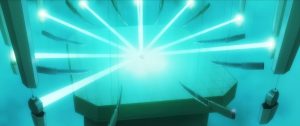 This may be my favorite Revue of the movie. Because it is so complex. Because it is emotional. Because it is two characters recognizing the faults in one another. And because, by clashing with each other and by calling each other out, they both find the things they had been looking for. Oh, and the music is excellent, too!
This may be my favorite Revue of the movie. Because it is so complex. Because it is emotional. Because it is two characters recognizing the faults in one another. And because, by clashing with each other and by calling each other out, they both find the things they had been looking for. Oh, and the music is excellent, too!
From Banana’s point of view, Junna was a Stage Girl who was at her brightest not because she was the most talented, but because she never stopped reaching for her goal, even if it was unachievable.
“Even though you couldn’t become the lead, the appearance of you foolishly, insistently reaching out your hand to the lead… It was dazzling.”
That quote is, of course, referring to Junna’s lines about herself from the series:
“Everyone has their own star. Stars that shine. The morning star. Stars that fall. Though I may not yet see my own star, I gaze upward and on this day I, Junna Hoshimi, will take hold of a star of my own.”
So, what changed? Why is Banana now urging Junna to give up completely. I think it’s because Banana see’s Junna’s chosen path as a form of giving up. Everyone else is going to some prestigious theater troupe or acting school. Junna? Her first choice is a literature department at a university! Meaning, she is withdrawing from being a Stage Girl. This plays into the criticism Banana threw at Junna (literally, in the form of her short sword) during the Revue of Annihilation:
“You can’t get by with nothing but words, don’t you know that?”
Now, she says of Junna:
“You’ve been blinded by the stars you can’t reach, and now you can’t see anything.”
Meaning, she thinks Junna was so in awe of others like Maya that she has given up trying to reach their level.
 Now, it’s true Junna was planning to withdraw from theater for a while in order to better understand the stage. But it’s so she can become an even better Stage Girl. That’s something Banana can’t see. Banana has a set role she sees Junna in and it never included Junna giving up.
Now, it’s true Junna was planning to withdraw from theater for a while in order to better understand the stage. But it’s so she can become an even better Stage Girl. That’s something Banana can’t see. Banana has a set role she sees Junna in and it never included Junna giving up.
In some ways Banana has a point. In some ways Junna has relied too much on the words of others and not enough in her own talent. Junna is very smart, but she doubts herself. She always ranks herself lower than others. And even though she claims to want to stand out, to be distinct from the others, Junna has always fought with a bow and almost always from the safety that comes from the height of her flying ring or the shadows at the edge of the stage she tends to hide in.
Banana’s harsh criticism very nearly breaks Junna. Visually, we see this as Banana breaking the crystal on Junna’s bow. It’s only after her best friend and roommate straight up tells her that she doesn’t feel a spark of glimmer in her acting that Junna finally begins to stand up for herself. We finally get to see a truly new side of Junna for the first time. It’s a side that partially agrees with Banana that the words of others are not enough. A side that agrees that just reaching for a star but with no hope of being able to land a lead role is not enough. This new Junna will still reach for her star, but now she will do so until she obtains a lead role. She finally has enough confidence in herself that she really thinks becoming a star is possible.
 This also isn’t in Banana’s plans. Banana is used to the kind, sweet Junna who strives and strives but is ok with never achieving. She doesn’t understand this new Junna… and Junna calls her out on it! Junna says:
This also isn’t in Banana’s plans. Banana is used to the kind, sweet Junna who strives and strives but is ok with never achieving. She doesn’t understand this new Junna… and Junna calls her out on it! Junna says:
“I don’t need the role you’ve given me.”
And
“The one who is being blinded by the light is you.”
Dang. And, those aren’t just references to their current conflict. Those are references to Banana’s unending time loop from back in the series.
In the anime, when Banana and Junna met on the lawn after Hikari and Karen ended Banana’s reenactments, Junna was just there to be comforting to Banana. She gave Banana quotes that basically said everything was ok because everyone makes mistakes. She held Banana while she cried. She noted that even while controlling the lives of everyone and keeping everything perfect for everyone, Banana was still playing with the script of her time loop behind the scenes. She was still trying to make things even better, Junna acknowledged. Junna never criticized Banana… until now.
The reason Banana trapped everyone in her loop was because she was so blinded by the 99th Starlight that she didn’t want to even try to top it. To her, it was perfect, and by setting everyone’s roles in stone, she could protect everyone from hardship and failure. Junna’s responses about being given a role and about Banana being the one who was blinded are subtle but sharp, jagged criticisms of what Banana did to her and everyone else. What Junna is saying here is everyone, herself included, is trying to move forward while Banana is still blinded by the past. Maybe they aren’t moving forward in the way Banana would choose for them, but where they go and what they do in the future is not Banana’s choice to make. Junna, for the first time, is telling Banana she was wrong to trap them in a perfect world where they couldn’t change or grow. She is pointing out that it was Banana who was so blinded by her experiences that she would prevent her friends from moving forward. That’s pretty harsh from Junna, but I think it’s also pretty fair.
The Revue ends in a very interesting way. From Junna, we see clear confirmation that she has embraced a new confidence and sees herself eventually reaching a leading role on a stage of her own. And from Banana, she says something really neat:
“A brilliance like jewels set ablaze. I’ve finally arrived at it. Thank you Junna.”
 This is very noteworthy! The whole reason Banana looped again and again was to protect everyone from the pains of moving forward, yes, but in her own words, in the seventh episode of the series, she wanted to redo the 99th performance of Starlight because it was:
This is very noteworthy! The whole reason Banana looped again and again was to protect everyone from the pains of moving forward, yes, but in her own words, in the seventh episode of the series, she wanted to redo the 99th performance of Starlight because it was:
“…a brilliance like jewels set ablaze.”
It’s the same words, or very nearly the same words that she says in the movie! By reaching farther and higher than she ever dared reach before, Junna was able to show Banana something that equaled that first perfect performance of Starlight Banana could never manage to get out of her head. That’s very powerful. Banana now truly understands that she can find a new stage and she can find new moments that dazzle her like the 99th Starlight did.
I love that Banana finally found the one thing she could never reach even after hundreds of years of looping, and that it was her friend Junna who gave it to her! I really do hope they get to perform with each other again one day.
Gotta give a callout to the music here as well. It’s really interesting at how strongly it calls back to the Revue of Annihilation until Junna rises to power and shifts everything in her favor. The moment where she takes over the review is very powerful thanks in large part to the build up and climax the music goes through.
Revue of Souls
 Here it is. The big Maya vs Claudine Revue that we never got during the series. We saw the aftermath of one, with the stage all destroyed and Claudine defeated, but beyond the intro to the show that showed Maya and Claudine crossing swords, we never got to see them fight each other. But now we have. And it was glorious.
Here it is. The big Maya vs Claudine Revue that we never got during the series. We saw the aftermath of one, with the stage all destroyed and Claudine defeated, but beyond the intro to the show that showed Maya and Claudine crossing swords, we never got to see them fight each other. But now we have. And it was glorious.
Sure, the Revue has awesome set design, awesome costumes, and a great call back to Maya’s first Revue with Karen, but it also gives us one thing we never truly got in the series. We get to see what Maya thinks about herself. All throughout the series, Maya Tendo was the perfect Stage Girl. She was always there to help. She always recognized and accepted and appreciated challengers. She was always giving correct advice to people like Kaoruko and Banana. But why? What was in it for Maya?
It turns out what was in it for Maya was living up to the expectations placed on her by everyone else. But, doing so always meant having to limit her own emotions and reign in her own desires. The Perfect Stage Girl is a part that she thought she had to play.
The problem seems to be that Maya has never been defeated. She has always been the best. And because of this she has always been full of pride and arrogance. Even Hikari and Karen weren’t true rivals for Maya. They managed to outshine her and Claudine momentarily, but they were so focused on each other and their childhood promise that who they were up against hardly mattered.
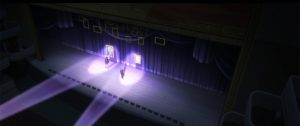 But then along comes Claudine, someone just as dedicated to the stage as Maya is. Someone who challenged Maya directly on the first day they met. Yes, Claudine had a bit of a shock when she found that Maya was her equal and maybe more, but we learned near the end of the series that Maya remembered being impressed by Claudine, as well, on their first meeting.
But then along comes Claudine, someone just as dedicated to the stage as Maya is. Someone who challenged Maya directly on the first day they met. Yes, Claudine had a bit of a shock when she found that Maya was her equal and maybe more, but we learned near the end of the series that Maya remembered being impressed by Claudine, as well, on their first meeting.
Now, the two finally recognize that yes, they are each other’s true rival. That no one else they’ve ever met compares to each other. And Maya in particular finds she has to truly go all out to compete with Claudine. I love that trio of lines they say to each other:
For heroes, there are trials.
For saints, there are temptations.
For me, there is you.
My mind is pulled off to Hercules and Odysseus and Joan of Arc. Epic figures in history that now Maya and Claudine count themselves among. It’s pretty freaking cool!
 There’s another little part of this Revue that I missed the first time. When Maya and Claudine are playing their little board game, Claudine admits that she had lost her love for the stage. She says she was dying inside because she had enjoyed working under Maya so much that she didn’t want to seek out her next stage. This adds some interesting context to Claudine’s part of the Revue. Her desire to have Maya acknowledge her as a true rival is rooted back in the way she almost became content with being in second place during their episode 10 Revue duet.
There’s another little part of this Revue that I missed the first time. When Maya and Claudine are playing their little board game, Claudine admits that she had lost her love for the stage. She says she was dying inside because she had enjoyed working under Maya so much that she didn’t want to seek out her next stage. This adds some interesting context to Claudine’s part of the Revue. Her desire to have Maya acknowledge her as a true rival is rooted back in the way she almost became content with being in second place during their episode 10 Revue duet.
But now, we get a renewed Claudine who, for the first time ever, was able to beat Maya. It was important for Maya to come to terms with her feelings of stoicism and importance, but it was just as important for Claudine to rekindle that spark of competition within herself. By the end of the Revue both Maya and Claudine are truly ready to seek out their next stage and even ready to fight each other as friendly rivals for future roles.
Oh yeah… and that musical callback to Karen and Maya’s Revue of Pride right as Maya and Claudine run at each other… that was amazing! Another great callback was the way Claudine and Maya did their final dramatic introductions of themselves after switching to their Revue uniforms. Each is parroting and mocking the other’s introductions they gave from the latticework of the Tokyo Tower on the Stage of Fate before their Revue in episode ten against Karen and Hikari.
The Final Lines
 And finally, we come back around to Karen and Hikari. This Revue is certainly the most abstract of them all. It’s also one that most directly challenges where things left off in the anime. In some ways, it even reverses some of the strongest positions espoused by the main series.
And finally, we come back around to Karen and Hikari. This Revue is certainly the most abstract of them all. It’s also one that most directly challenges where things left off in the anime. In some ways, it even reverses some of the strongest positions espoused by the main series.
All throughout the movie we’ve been seeing flashbacks of how Karen came to truly love the stage and how her promise with Hikari went from a child’s simplistic promise to a driving force in her life. It wasn’t just a fleeting promise, it was something that Karen held onto tightly for more than thirteen years as she grew from a child to an adult. Was Karen a little naive? Sure. But her faith in her promise was rewarded in the end.
What this Revue points out is that no matter how heartwarming it was in the anime when Karen said, “My stage is you, Hikari,” it was also a deeply flawed position. I love how they showed how incredibly grateful Karen was to Hikari for giving her the inspiration to join school plays and train in dance and acting and to join Seisho Music Academy. But also how they showed just how solely focused Karen was on Hikari to a ridiculous extent.
That scene where both Karen and Hikari turn to the audience watching them is fantastic. It’s a great fourth wall breaking callback to the Giraffe addressing us, the anime viewers, directly in the final episode of the series. Karen made it clear that all this time she barely even noticed the trials and hardships everyone was going through on stage. She never noticed the audience appraising and criticizing her performances. She never noticed the stage lights or any of the other technical challenges that come with acting on a stage. She never even noticed how scared everyone was to be putting themselves out in front of an audience. She ignored all of that because she was so focused on being in a position to do Starlight with Hikari…
…but now they’ve done it. They performed the lead roles in a play of Starlight. Mission accomplished. But, because Karen is as simpleminded as she is, she never thought beyond that point. The anime conveniently never addressed what comes next. It just gave us a happy ending. I love that the movie moves a step beyond and asks: “…and then what?”
What happens next is Karen realizes she doesn’t know what to do. In her perfect world, she and Hikari would be side by side forever. In the real world, Hikari went back to her home in London. In the real world, Karen is a brilliant actress who expected to always have her best friend by her side and now doesn’t. Karen feels dead inside because of all this. She just recently had the time of her life. She did the one thing she’d been looking forward to all her life… but it’s over now and she has nothing else she wants to do.
 So what fixes Karen? Well, for one thing, Hikari makes a pretty stunning admission. When they were watching Starlight as children, little child actress Hikari was so in awe of it that she was afraid that she might not ever reach that level. So afraid that she nearly gave up, in fact! It took Karen’s dumb raw idealism and the insistence that they promise each other to do their own Starlight to snap Hikari out of it. If Karen hadn’t been there, Hikari might have given up on being a Stage Girl all the way back when she was five. That’s a pretty awesome revelation! It helps give Karen some amount of fulfillment that her promise wasn’t just an empty thing for herself. She unknowingly saved Hikari way back then!
So what fixes Karen? Well, for one thing, Hikari makes a pretty stunning admission. When they were watching Starlight as children, little child actress Hikari was so in awe of it that she was afraid that she might not ever reach that level. So afraid that she nearly gave up, in fact! It took Karen’s dumb raw idealism and the insistence that they promise each other to do their own Starlight to snap Hikari out of it. If Karen hadn’t been there, Hikari might have given up on being a Stage Girl all the way back when she was five. That’s a pretty awesome revelation! It helps give Karen some amount of fulfillment that her promise wasn’t just an empty thing for herself. She unknowingly saved Hikari way back then!
The other thing that fixes Karen is the thing that always fixes Karen: The idea that she can be reborn as a Stage Girl and face the next challenge. Karen, lovable as she is, is kinda a dummy who often does the right things without realizing the deeper why. I think Hikari’s revelation jumpstarted Karen and caused her to look back on all the fun and challenging times she had as a Stage Girl growing up. It caused Karen realize that, no, her stage was not just Hikari. Sure, doing Starlight with Hikari was a huge goal, but Karen was a real Stage Girl and a star long before she and Hikari met again at the start of the anime.
We see a scene where Karen’s three past selves deliver a tomato to her comatose self. The tomatoes all throughout the movie have represented the willingness and desire and sacrifice to take on the challenge of continuing to be a Stage Girl. Karen had ignored that tomato and walked away from those challenges, but now she had it back in hand. So, Karen goes back to the beginning. We literally see her become Position Zero. She has to ride through her brief storm of insecurity and doubt, but she comes through it just fine and is once again reborn as herself, but now she clearly remembers and cherishes everything it took to reach this point.
After all that, Karen’s post-transformation introduction is forward looking to new stages instead of being focused on the stages of Hikari and the Starlight play. Karen now realizes one last thing that she never even considered before. Now that she and Hikari are going their separate ways, they might just end up competing against each other for the same role. Up until now, Karen has maintained that they could pass their Starlight auditions together. Now, Karen realizes that if she ends up going against Hikari she will want to win. It’s Karen’s last step to becoming a true Stage Girl. And yes, this newfound desire to be the best rips apart Karen and Hikari’s Promise Tower, but the promise had already been fulfilled. It will always be great memory the two will share, but it cannot hold up to the reality of the new stages they are heading towards.
 This is quite the departure from the series. It drags Karen a bit more into the real world. One where she knows she might have to defeat others in order to get the roles she wants. Even so, I think Karen will still be the lovable goofball who immediately came to check on and praise Junna for a job well done after their second Revue together. Karen will now try to win, but she won’t seek to destroy her opponents like some stars sometimes do.
This is quite the departure from the series. It drags Karen a bit more into the real world. One where she knows she might have to defeat others in order to get the roles she wants. Even so, I think Karen will still be the lovable goofball who immediately came to check on and praise Junna for a job well done after their second Revue together. Karen will now try to win, but she won’t seek to destroy her opponents like some stars sometimes do.
In the end, the top of the tower lands on Position Zero, and although Karen is empty from having accomplished her Starlight promise, Hikari tosses her a tomato. Karen can now fill herself up on the ambition of being a Stage Girl. She will be alright now, even as she moves into the real world beyond her childhood. And the movie ends.
Except it doesn’t! Stick around for the credits! We get to see where everybody ends up!
– Kaoruko inherits her position as the 12th Generation leader of the Senka-ryu dance school.
– Maya, Mahiru, and Futaba join the New National First Theater Troupe. (Maya can go anywhere she wants, I’m sure, but I’m a little surprised the other two got in!)
– Claudine joined the Theatre de Flamme in France. But, I’m thinking Maya came to visit at least once since Claudine has a cute little dove in her window.
– Junna did not go to a university literature department! She joined a New York Musical and Drama Academy and is dancing and having fun! Yay, Junna!
– And Banana? She joined the Royal Academy of Theatrical Actors… that’s where Hikari is studying! Maybe we can count on Banana (and Hikari?) giving that Judy Knightley, who ended Hikari’s quest to become a Top Star in the anime, a run for her money next time there are auditions? :p
– As for Hikari, she seemed to be traveling the world visiting her friends, but we last see her at her own Position Zero. There’s a ton of little hints throughout the movie that Hikari actually fully quit out of acting after doing Starlight with Karen, but now she is going back to it. I think it would be fun if she and Banana went from super rivals to best friends.
– And Karen? She has a new audition for a new role, but she’ll happily use her experiences of Starlight to help herself along! 🙂
Bite-sized Backstory 1: Fundament
Destiny’s history starts some fifty thousands years ago within the layers of a gas giant called Fundament. Unlike the gas giants in our solar system, Fundament is host to well over five hundred species.
Most of these species live in the dark beneath the outer gas layers of Fundament on a large number of continents all floating on a massive sea that is suspended between storms and gas clouds overhead and the gas giant’s increasingly thick oceans, liquid metals, and solid layers below.
We don’t learn much about the numerous inhabitants of Fundament. Only one of the five hundred plus species gets much detail.
This race of three eyed humanoids are described as the smallest, weakest things on the seas of Fundament. Living gas clouds with glowing balls at the end of long tentacles reach down from the storms above like flying anglerfish and try to eat them. Acidic rain and deadly lightning storms occur frequently and kill many of them. And even though they have cities and science and some level of seafaring technology, they sometimes wage war on each other and demand sacrifices and eat their own. Maybe worst of all, this smallest of races usually only live 8 – 10 years.
There are a few other interesting things we learn about this three-eyed race:
– They all appear to be born female.
– At around four years of age they choose to morph into one of three forms: The king morph, the knight morph, and the mother morph. Notably, mothers live significantly longer than the others, but we are not told how long.
– This race, and many of the others, did not evolve on Fundament. Instead, they arrived on the gas giant’s hidden, suspended seas when each of their planets collided with Fundament long before anyone can remember.
Unfortunately, this weak, short-lived, three-eyed race is never given a name, but they eventually rise up above their lowly station and do much to shape the world of Destiny.

